70 Years: A Celebration of Glynn Visual Arts
70 Years: A Celebration of Glynn Visual Arts
70 Years: A Celebration of Glynn Visual Arts 70 Years: A Celebration of Glynn Visual Arts
70 Years: A Celebration of Glynn Visual Arts





70 Years: A Celebration of Glynn Visual Arts
70 Years: A Celebration of Glynn Visual Arts
70 Years: A Celebration of Glynn Visual Arts 70 Years: A Celebration of Glynn Visual Arts
70 Years: A Celebration of Glynn Visual Arts







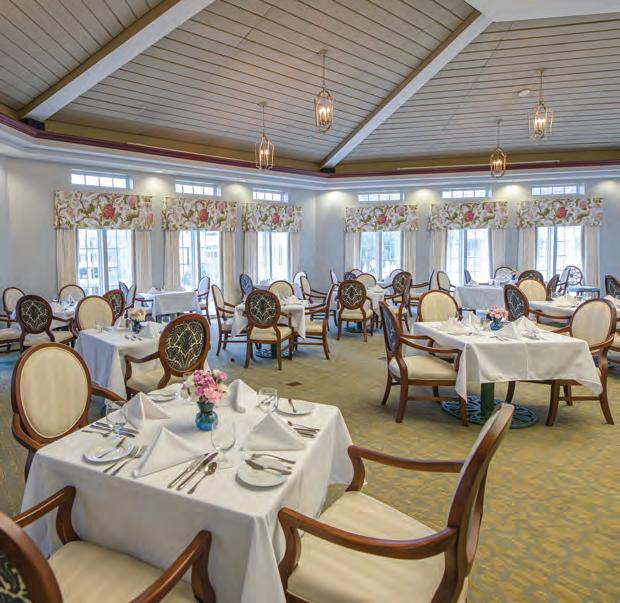




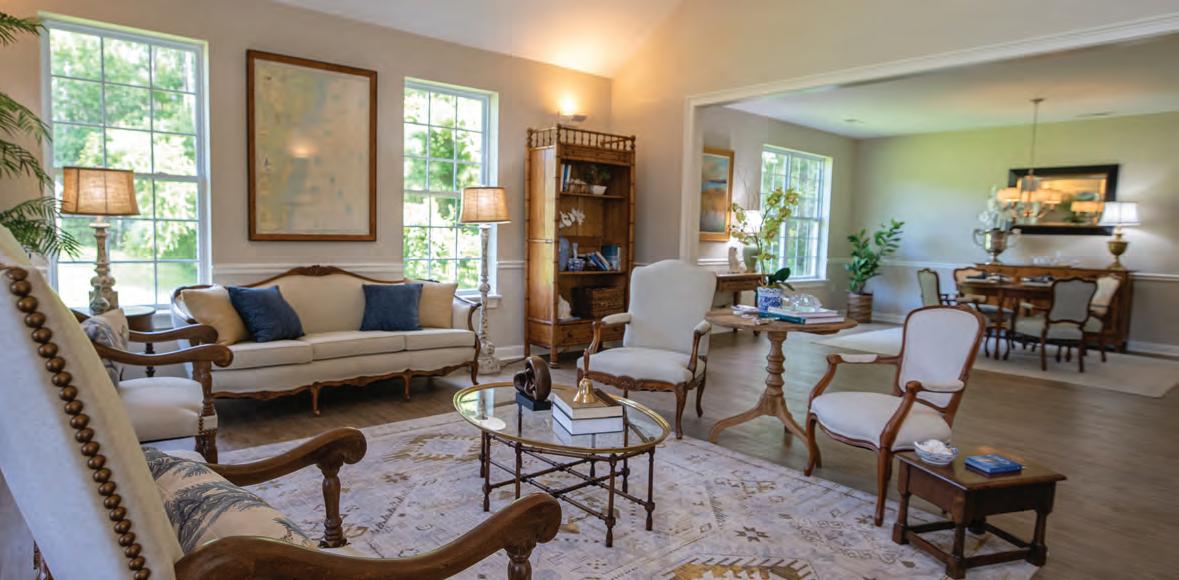











Webster Hill has cornered the market on hot dog stands. Literally. He set up his popular Greg’s Junkyard Dawgs in 2021 at the corner of Gloucester and Stonewall Streets. But it was Joe Riccio at PrimeSouth Bank who helped Webster turn the corner in his career. Joe knew Webster had come a long way, and had a story of overcoming obstacles which draws customers as much as his famous dogs. Webster says Joe has not only been his lender, but a mentor helping him build credit and spend wisely while building a following. When people ask Webster his secret, he just says, “Keep it simple and real.” Which is a great way to do banking.
Learn more at: PrimeSouth.com
 L to R: Alexandria Hill, Webster Hill, Owner, Greg’s Junkyard Dawgs and Joe Riccio, Senior Commercial Lender, PrimeSouth Bank.
L to R: Alexandria Hill, Webster Hill, Owner, Greg’s Junkyard Dawgs and Joe Riccio, Senior Commercial Lender, PrimeSouth Bank.
SEPTEMBER/OCTOBER 2023
Local artist Toni Bangala shares her love of alcohol inks, which offer a sense of fluidity and movement unlike traditional mediums.

A prolific creator Kevin Pullen has mastered multiple art forms — painting and sculpting — and shares his passion with local art lovers and students.
Glynn Visual Arts on St. Simons Island has spent the year celebrating its 70th anniversary.
Two local groups of shouters have kept the ring shout — originally practiced by enslaved Africans — alive and they share their heritage with audiences throughout the region and beyond.
Potter Elizabeth Hayes is continuing an art form as old as time, using the beauty of the natural world to craft dishes for meals.















Dresses, Dresses, Dresses
Publisher Buff Leavy
Editor
Director of Advertising and Marketing

Lindsey Adkison
Jenn Agnew
Assistant Editor Lauren McDonald
Proofer
Account Executive
Heather Murray
Kasey Rowell
Contributing Writers Taylor Cooper
Derrick Davis
Terry Dickson
Sam Ghioto
Michael Hall
Larry Hobbs
Ronda Rich
Cynthia Robinson
Priscilla Boudreau
Contributing Photographers
Derrick Davis
Sam Ghioto
Michael Hall
Leslie Hand
Allyson Reynolds
Tom Sweeney
Contributing Designers

Stacey Nichols
Donte Nunnally
Terry Wilson
Golden Isles Magazine is published six times per year by Brunswick News Publishing Company
To subscribe online to Golden Isles Magazine, go to goldenislesmagazine.com/subscribe
About the Cover: Local painter, sculptor, and educator Kevin Pullen is pictured in the lobby of the Liberty Building in downtown Brunswick. Three of his large paintings are displayed there as part of the private collection of the Prince family, who own the building. They feature a number of historic Black leaders including Harriet Tubman, the Tuskegee Airmen, and Nelson Mandela. Pullen’s work will be featured in an upcoming exhibition to be held September 12 to October 13 at Glynn Visual Arts. He was photographed by Priscilla Boudreau of DeVoss Photography.

155 Skylane Road St. Simons Island, GA 912.638.7700
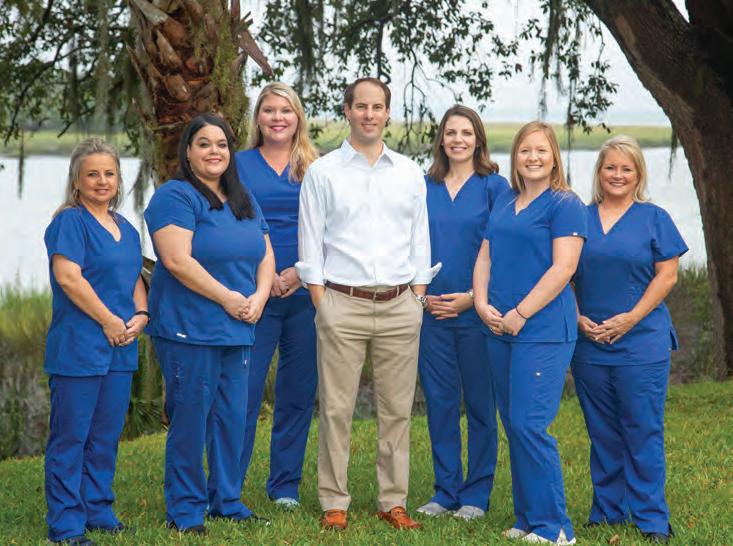
Monday thru Saturday 9:30 am - 5:30 pm

Golden Isles Magazine is in need of talented contributors. Unsolicited queries and submissions of art and stories are welcome.
Please include an email address and telephone number. Submit by email to the editor, Lindsey Adkison: ladkison@goldenislesmagazine.com or by mail to 3011 Altama Ave, Brunswick. Only work accompanied by a self-addressed stamped envelope will be returned.

Information regarding advertising and rates is available by contacting Jenn Agnew at 912-265-8320, ext. 356 or by email at jagnew@thebrunswicknews. com; or Kasey Rowell at 912-265-8320 ext. 334 or by email at krowell@thebrunswicknews.com;
All content is copyright of Golden Isles Magazine, a publication of Brunswick News Publishing Company. All rights reserved. No part of this publication may be reproduced in any form without express written permission from the publisher. We have sought to ensure accuracy and completeness of the content herein, but neither Golden Isles Magazine nor the publisher assumes responsibility for any errors, inaccuracies, omissions, or other inconsistencies, including those related to quotations. We reserve the right to refuse advertising. All advertisements appearing herein are accepted and published on the representation that the advertiser is properly authorized to publish the entire contents and subject matter thereof. All ads are paid advertisements and/or gifts given as part of a contractual agreement regarding Brunswick News Publishing Company. Neither Golden Isles Magazine nor the publisher is responsible for any statements, claims, or representations made by contributing writers, columnists, or photographers. Golden Isles Magazine and the publisher are also not responsible for anyone’s reliance on the content included in the publication. All projects described in this publication are for private, noncommercial use only. No right for commercial use or exploitation is given or implied.
Thoughtfully crafted, timeless, Southern clothing for boys & girls.
























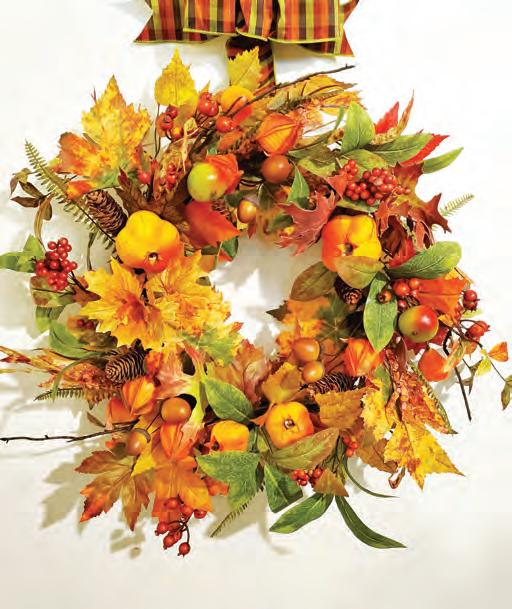





A search of the word “hub” yields terms like “center” and “core” — and perhaps less common, “stronghold.” But the definition I like best is a bit more utilitarian, “the central part of a wheel, from which the spokes radiate.”
Most of the artists found on the walls of the area’s fabulous galleries have touched or been touched by this special nonprofit.
Artistically
I like that most because, to me, being at the center of something is of little value if you don’t give something back ... if you don’t “radiate.”
And this is why Glynn Visual Arts (GVA) can truly be dubbed the Golden Isles’ artistic hub. Since 1953, the center has been at the heart of the creative community. From offering classes to exhibitions, galas to outdoor art sales, no other place has “radiated” quite like GVA has.

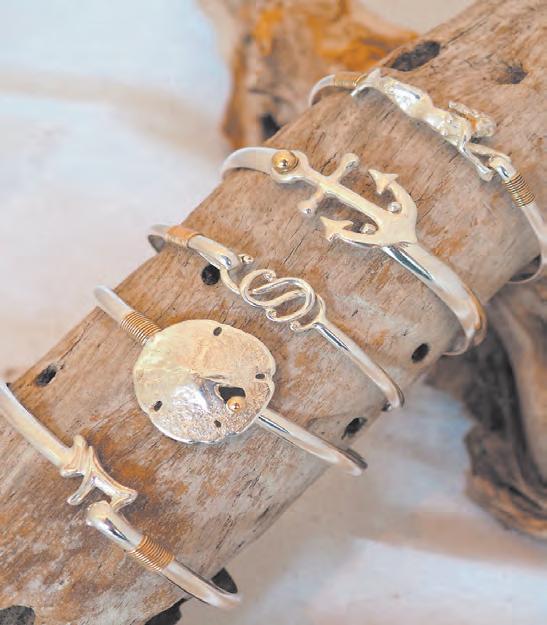
Most of the area’s artists have links to this organization. It could be that they took their first painting class on site or the gallery has hosted their work. It may be the place where they learned a new technique or skill.
But it goes even deeper. Many were able to connect with like-minded people who helped spur their growth or walked them through a hard time. It has fostered friendships that have lasted literal lifetimes.
For me, it was one of the first places I conducted an interview when I started with the newspaper, now nearly two decades ago. Back then, it was in the Pier Village. Coincidentally, or honestly probably not, it was just as light, bright, and airy then as it is now. I think that happens to a place when beauty is nurtured there. It doesn’t matter the physical location or the style of the building — the beauty will always blossom.
Over the last seven decades, the center has taught this community to appreciate new art and to think in ways we’ve never thought. That, ladies and gents, is a true treasure.
So for our 2023 Arts Issue, we are highlighting a few of the folks who have helped the center thrive. Don’t get me wrong, I realize that there are countless fingerprints on this organization. There are far too many for us to squeeze into one issue. After all, it’s been seven decades. That’s a lot of creating and a whole lot of artistic ripples rolling through our community. But we’re honored to showcase a few of its gems.
To start, Cynthia Robinson sat down with new-ish director Michelle Register, as well as some “long-timers” to learn more about the development of the center. I profiled three artists — Kevin Pullen (painter, sculptor, teacher, and general genius), Toni Bagala (alcohol ink, glass artist, and teacher), and Elizabeth Hayes (potter, pottery studio director, and instructor) — to learn about their respective crafts (obviously several) and history with GVA.


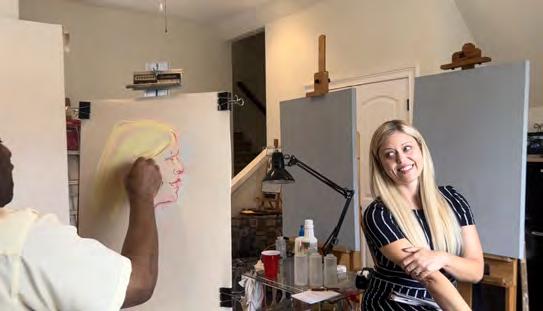
Last, but certainly not least, Larry Hobbs spoke with two groups of shouters — the Geechee Gullah Ring Shouters and the McIntosh County Shouters — to learn about the Art of the Shout. This story links back to GVA and its ongoing 70th anniversary theme of celebrating the “Art of the Low Country,” which heavily inspired this issue, as you can see.
It’s uncommon to have an entire issue
of Golden Isles Magazine dedicated to one source, but GVA is not your average place either.

It’s a “center,” a “hub,” a “stronghold” of our collective imagination. And we’re so very grateful for that. May you continue to inspire, to sparkle, to shine, and to radiate.
Cheers to another 70 years
— Lindsey
The sketch of me was completed by our cover guy Kevin Pullen in less than 20 minutes at his home studio during our interview. We also included some shots of the master at work snapped by our UGA intern Allyson Reynolds.@palmcoastopenmic: Incredible photo
@zoen_designs: Beautiful cover
Emily Burton Designs: Love the cover!
Aleta Walker: Such a great magazine!!
Susan Busby Thornton: The cover! Wow.
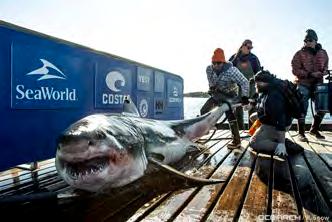
Open Gates Bed & Breakfast: This is a great story and why we love to live in this hidden gem of the Golden Isles.
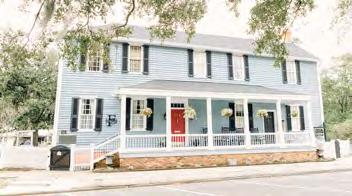
Katie Hopkins Lee: Great read, stay safe out there!
Stephen Moreno: Dang, D.J. Lettieri, you’re a celebrity!
Kristine Biemiller-Emmons: What an amazing thing that the boys are doing! So awesome!
Alice Dunick: Can’t wait to read it!
Ren Halverson: Huh, I had no idea.
Hans Trupp: Very interesting story. Can’t wait to read it.
ss_island_rambler: Love these stories so much!
Jim Orser-Schwalm: We might
instagram.com/goldenislesmag
facebook.com/goldenislesmag twitter.com/goldenislesmag
If you prefer to send us your comments by email, contact Editor Lindsey Adkison at ladkison@goldenislesmagazine.com. Anything posted to our social media accounts or emailed directly to the editor will be considered for publication. Comments may be edited for clarity or grammar.
have to take a trip down to St. Marys to investigate!
Susan Garrett: I absolutely loved reading this edition of GIM. Being a lover of the history of the Golden Isles, the stories were fascinating to me. And the piece on the Okefenokee — WOW! What a treasure it is. Thanks Lindsey and all the writers who contributed to this issue.

Trevor Greco: I want to be like D.J. when I grow up.
Ann Barnes: What a great article and such wonderful comments and thoughts on our community!!
Sherril Sumner: Wonderful article about our home and our sweet community.
Lesley Mercile Flounoy: I’m so happy that they love our little town as much as we do!

@emmythomo: it @samghiotostudio
Anne Packard: Absolutely gorgeous!




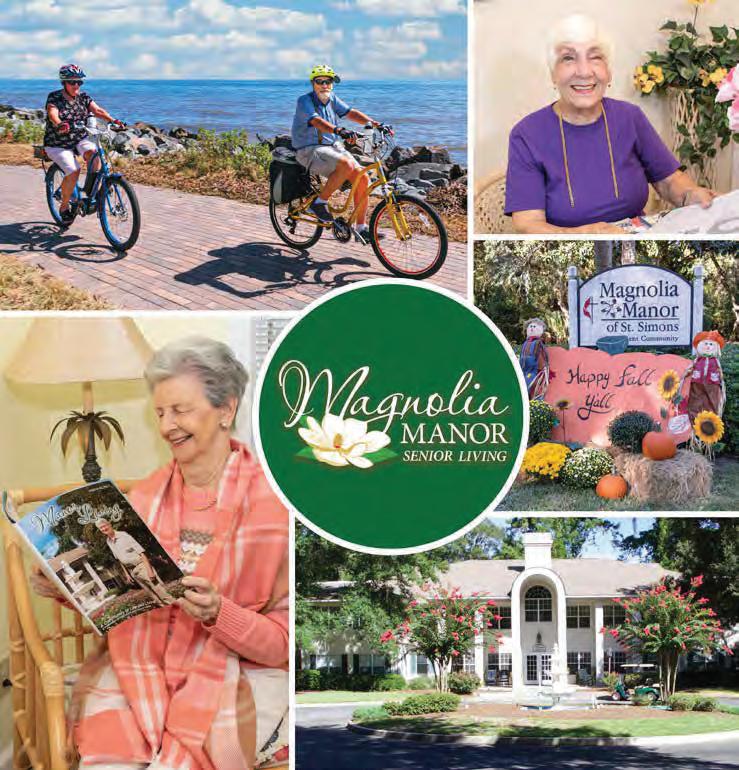



“Macbeth.”
“Hamlet.”
“A Christmas Carol.”
Some of the greatest stories from classic literature are, in fact, ghost stories.

Spine-tingling tales of a world beyond the veil have always captivated us. The reasons are varied, but as one expert, Stephen King, put it, “We need ghost stories because we, in fact, are the ghosts.”

Like those who have gone before us, we’re all muddling through life as best we can. And one day, we too will be gone, leaving the stories of our lives behind. Creating a connection to those who have walked

the path before us seems ever inviting. That’s why places like the Jekyll Island Historic District call to us.
Dotted with multiple “cottages” belonging to some of wealthiest families of the 19th century — the Rockefellers, the Vanderbilts, and the Morgans — it’s a literal peek into the past. But sometimes that may not be as far removed as it seems.
Stories of long-dead residents revisiting the location have been shared for decades, both by guests and historic district staff. And each fall, the Jekyll Island Authority offers a special tour to highlight some of the spookiest spots throughout the historic district.
place on weekends in October — Gilded Age Ghosts & Ghouls, which features stories about the macabre and unusual past of Jekyll Island,” says Alexa Hawkins, director of marketing and communications with the Jekyll Island Authority.
“The Gilded Age Ghosts & Ghouls tour launched last year and received rave reviews. Jekyll Island certainly has its share of history, some of it darker than others, but all of it important to tell. Because the weather is more tolerable this time of year, it’s a great time to experience an after-hours look at the Jekyll Island historic district.”
Some of the stories shared include the unexplained death of a young WORDS BY LINDSEY ADKISON | PHOTOS PROVIDED BY MOSAIC, JEKYLL IS LAND MUSEUM
“Our biggest fall feature takes
Thursday,
Tuesday,

When


club member, the sighting of an apparition of a servant of the Gilded Age, and even a more recent experience with the long-deceased wife of a former Jekyll Island Club member.






These tours have proved incredibly popular and Hawkins believes that speaks to the public’s interest in the “other side.”
“I think people are fascinated by anything supernatural because it’s often unexplainable. It presents a question about what is fact or fiction and gives people a glimpse into the past. These tours provide you with a more personal look at the places where these stories, and lives, began and how that history might be interconnected with the modern day,” she says.
“Historic tours are always a little more fun, and perhaps a little hair-raising, under the moonlight. This particular tour highlights stories of the past only told during this time of year. These are stories about those who lived here, died here and potentially never left. Tours are available all the way through Halloween night.”
• To book a tour, visit jekyllisland.com
To help you get in the spooky mood, here are five of the many haunted hot spots in the Jekyll Island Historic District. :
• Indian Mound Cottage — Constructed by Gordon MaKay in 1892, it was bought by William Rockefeller in 1905. The home was named for a large grassy hill in its yard, which was thought to be a Native American burial ground — however, it turned out to be a shell mound. It’s been said that glimpses of the Rockefellers have been seen moving around the inside of the expansive home, sometimes still dressed in their formal wear. Ghostly orbs and unexplained lights have also been reported through the years.

• Sans Souci — The second floor of this distinctive green building is supposedly a hub of supernatural activity. Original club member financier J.P. Morgan is rumored to have spent many an hour enjoying his cigars on the balcony. Today, guests report the smell of tobacco smoke drifting through the second floor corridor ... there’s no (earthly) smoking allowed.
• Hollybourne Cottage — This Jacobethan cottage was built in 1890 by club member Charles Stewart Maurice. For decades, it sat unrestored, and the reason was rumored to be the significant ghost activity. According to one tour guide, for years, no contractor would stay to finish the job. Materials and tools would be moved ... outside the home. Some even claimed to have had things thrown at them by unseen hands. But it seems the specters have mellowed in recent years, parts of the cottage have been renovated and preserved. Some spaces have even hosted weddings.
• Villa Ospo — Designed by John Russell Pope in 1927, the architect who designed the Jefferson Memorial in Washington, D.C., the cottage is one of the most modern structures in the historic district. The original owner was oil tycoon Walter Jennings. He was injured in a car crash and later passed away in his beloved home following a heart attack. Visitors have reported feeling watched, along with unexplained sounds and fragrances (phantom cigar smoke and perfume are often encountered).
• The Jekyll Island Club Hotel — Last but certainly not least, the Jekyll Island Club Hotel itself is believed to have several spirits walking its halls. Railroad magnate Samuel Spencer is said to appear in the club’s annex after his death in a train crash (one of his own trains) in 1906. He’s said to sip guests’ coffee and enjoy their newspapers while they’re out. Another oft reported ghost is that of a bellman from the 1920s. He’s said to appear on the second floor of the hotel, where he knocks on room doors, offering to press the suits of grooms before their weddings.
Fine art evokes emotion in the beholder, but the story behind each piece must be told by the creator.
Art lovers — and those just looking to stroll around Postell Park in the Pier Village on St. Simons Island and experience something beautiful — can look no further than this month’s Art Under the Oaks Art Festival, hosted by Glynn Visual Arts.
The event will feature over 60 juried talented artists and skilled artisans from around the Southeast. They will showcase their handmade work, including jewelry, ceramics, photography, textiles, wood, metal and glass, pottery, and more, and the artists will be on hand to discuss their craft and the stories of their work.
The Under the Oaks Festival will be from 10 a.m. to 5 p.m. September 23-24.

For the first time in several years, the festival will include a juried show, which elevates the quality of the fine arts that will be shown, says Michelle Register, executive director of GVA.
“It’s our 70th anniversary at GVA, and this is our 53rd year of doing Art Under the Oaks,” Register says. “We pack that park. It’s going to be full this year.”
The event showcases a variety of mediums and provides a venue where artists can share their wares. It also allows art lovers to meet these creators.
“It’s always nice to see new techniques and mediums,” Register says. “We look for artists who are pushing the envelope, who are doing something really extraordinary and really creative. And it’s especially nice at festivals because you get to meet the artists and talk to them personally.”
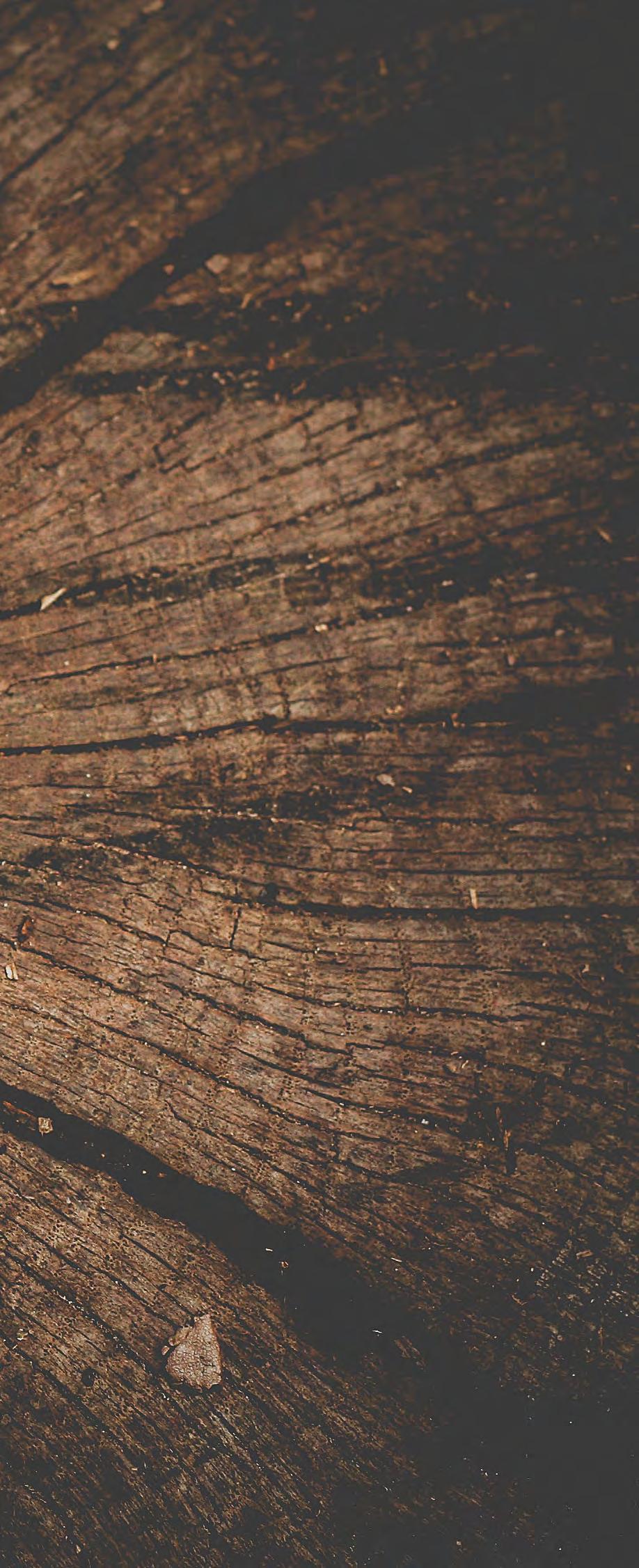
Artists can share their process.
“It’s really important to have that connection with the person who created that piece,” Register says. “That’s the fun part of going to a festival — you get to meet all of these talented people and hear the stories of their influence and what inspired them and how they created the piece, the techniques behind it.”
Artists travel the country for these kinds of fine arts juried shows, she says, and participants in this year’s festival hail not only from Georgia but also places like South Carolina, Florida, Kentucky, and Tennessee. Most have some tie to Coastal Georgia, though, Register says.


Many artists have been part of the Art Under the Oaks Festival and other GVA events for years, she says, including Dan Goad, Kenny Nobles, Kathy Stratton, Hannah Roberts, and Elizabeth Holladay.



Nobles, who leaned into his interest in photography after retiring from the Department of Public Safety almost a decade ago, says the festival brings a lot of talented artists together for an event well-publicized by its host.

Most of his photos feature coastal landscapes, from St. Simons and Jekyll islands, Darien, and other parts of

“Just about everything they’re going to view from me will be within a 40-mile radius, usually,” Nobles says.

Pauletta Berger, a weaver who has been honing her craft for four decades, will also participate in the festival, and she’ll bring her handmade scarves, shawls, placemats, and more.
She will also offer demonstrations, as she’s done in years past.
“It’s a great time to share how I do what I do and to encourage another generation of people that would want to weave and to explore fibers,” Berger says.

She looks forward to the return of the juried show at the Art Under the Oaks Festival.
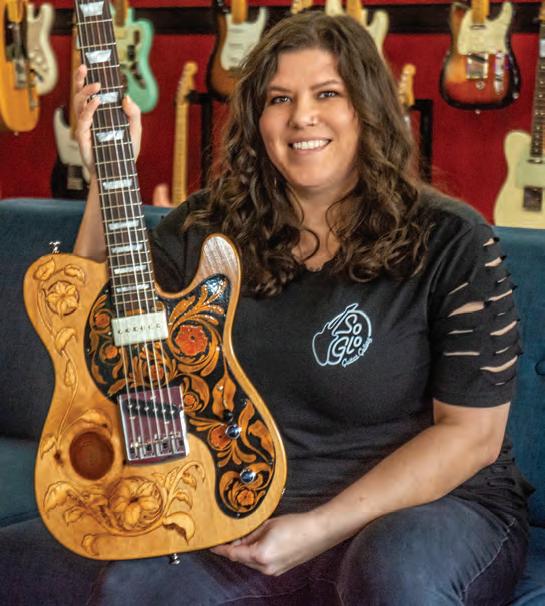


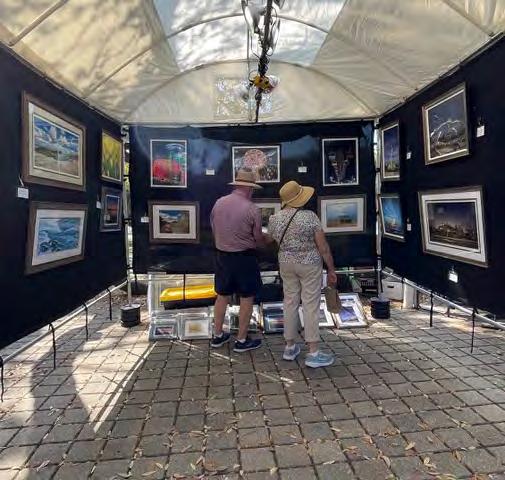
“A bunch of the shows I do are juried, and it brings the show to another level,” Berger says. “There’s a diversity of the crafts and the artists that are there. It’s another level of quality that’s there. I’ve always thought it’s a good show, and this will make it a little more professional of a show.”
GVA and the talented artists who participate in the festival never fail to put on a quality event, she says.
“The artists that are there, they just take their art to another level,” she says. “It’s not the same old products. It’s always mentally stimulating, and being on St. Simons and walking under the oaks is just relaxing and beautiful.”
• To learn more about the festival, visit glynnvisualarts. org/festivals.


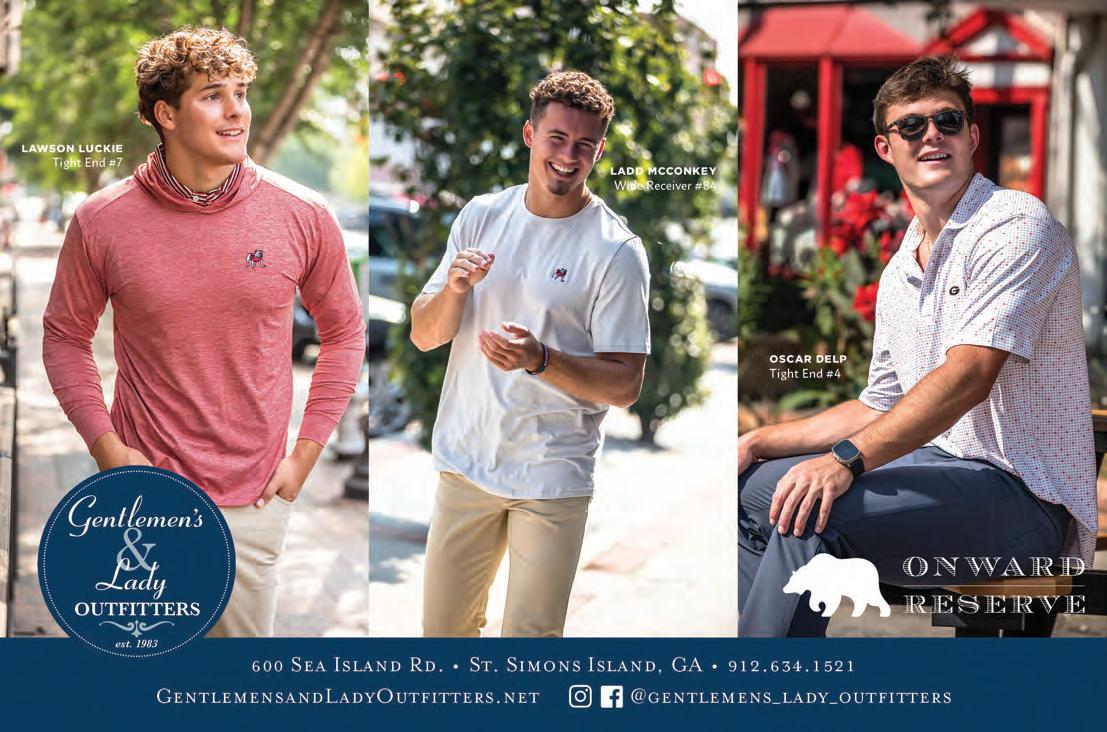
It’s a sad fact of life that art often goes underappreciated. Artists have to make a living, but outside major urban centers, the public typically only has sparse access to artistic performances — and to employment in artistic endeavors. Golden Isles Live was founded in 1938 to change that for the Brunswick area.
Angela Votsis and Bonnie Duncan, among others, lead the nonprofit’s board of directors in raising money and identifying talent to bring to the port city every year. Well, almost every year.
The 2019-2020 season was cut short because of the COVID-19 pandemic, and 2020-2021 didn’t happen at all for the same reason. Recently, the 2021-2022 season started late due, once again, to the pandemic. The 2022-2023 season was the closest to normal, but this year’s 20232024 series is actually what Votsis would call business as usual.
“This is the first full season back. We had to get a lot of new members,” Votsis says.
This season is kicking off with Vox Fortura, an all-Black classical vocal quartet that
was launched into stardom when the group made it to the semi-finals of Britain’s Got Talent.
It’s actually the group’s second time performing in the Golden Isles, says member Thomas Goodridge.
“We played at The Cloister At Sea Island. The venue was absolutely incredible. We thoroughly enjoyed our stay there, too.” Goodridge says.
For more information on concerts, tickets, and sponsorships, visit goldenisleslive.org.
A self-described actor, singer, and “prancer,” he’s performed in musicals, “The Lion King,” “The Book Of Mormon,” and “Sister Act,” among many others, working alongside such names as Tom Hardy and Hayley Atwell.
He trained primarily as an actor, attending a stage school at 12 where he studied singing and dancing.
“I grew up in the business and have also enjoyed time on the big screen working on various movies like ‘Spider-Man: Far From Home,’ ‘Avengers: Infinity War’ to name but a few,” Goodridge says.
A big part of Golden Isles Live! is the student outreach aspect. It’s Votsis and Duncan’s favorite piece, getting students into a show for free to see firsthand the practical application of the arts. Goodridge agrees. It’s one of the reasons Vox Fortura is always willing to perform for Golden Isles Live.
“I think it’s extremely important to expose kids to the arts as early as possible because it gives them creative options,” Goodridge says. “Kids are naturally inquisitive and, if engaged, it could be an amazing pathway to the arts for them. But it‘s entirely by choice. If they like a particular show that they’ve seen, it may inspire them to get involved.
“I would say to anyone wanting to pursue a career in the arts, to immerse themselves in their local amateur dramatic groups to work on their craft. I would also suggest researching where acting workshops are held locally to hone and perfect their craft. These are very useful for networking also.”

This year’s performance lineup also includes the Sounds of Silence performing 70s village folks tunes; the Sugarplums for the Christmas concert; classical crossover band The Suits; and, finally Key of G, a Garth Brooks tribute artist.
Duncan is very glad to be “back in full swing” this year. To her, this program is something the community really shouldn’t have to do without.
“We want to keep the series going because it was started 81 years ago by leaders in the community,” Votsis adds.
It’s especially popular for seniors and students, who may not want or be able to travel far to see performances of the caliber Golden Isles Live! offers.

Votsis recalled one of the free student days when the kids got the chance to ask Motown performer Chester Gregory some questions. One little girl, a head of curly hair and all energy, stood out to her.
“She was all wiggly in her seat, and when they called on her she composed herself, put her hands together and asked ‘I know you’ve been a performer for a while, but what have you done that you’re happy about, and what do you regret?’” Votsis recalled with a chuckle.
Gregory answered that he loved being a musician, and only wished he’d followed his heart earlier in his career. His answer also stood out to Votsis as something kids really should hear.
Of course, keeping it going is always a challenge. Patrons and ticket sales cover the cost of bringing performers to the Isles, but so many people changed their lifestyle due to of COVID-19. From Duncan’s experience, longtime supporters became accustomed to staying at home and playing it safe with their health.
More and more, Duncan said she’s seeing a lot of outof-town ticket sales from as far away as Massachusetts, Michigan, and Oregon, which she suspects are snowbirds — wintertime vacationers from Northern states seeking out more pleasant Southern climates.
That bolstered the 2022-23 season. Sail On, a Beach Boys tribute band, and 3 Divas sold out, getting them back in the black, so to speak.
Private and corporate sponsors typically pay for the rest of the expenses and form the foundation of Golden Isles Live! By “the rest of the expenses,” they mean anything and every thing else including everything that can possibly go wrong. It includes such expenses as hotel stays for the performers, taking them to try the tastes of the Isles at local restaurants, and transporting them around town.
It also covers things like a band only telling the Golden Isles Live! staff after they arrive that they’re not bringing a key piece of musical equipment, Votsis laughed.
She was referring to an instance in which a group needed a big standup harp. It seems obvious in retrospect, but the band wasn’t planning to transport the huge musical instru ment all the way from across the country. The sponsors cover last-minute things like that, she says with a laugh.
$100
Fee
We Can Help With:
Cold and Allergy Symptoms
Fever
Rash
Nausea and Vomiting
Sty in the eye
Yeast Infection
COVID-19 Testing
Flu and Strep Testing
UTI's
Stomach Aches and Pains
(912) 268-0099
WWW.COASTALCAREPARTNERS.COM



 WORDS BY TERRY DICKSON
WORDS BY TERRY DICKSON
Ophelia Dent died on Sept. 5, 1973, and just a few days later, her friend Bill Haynes saw something he wished she had lived to see.
Haynes remarked in a letter about seeing a number of “antique automobiles” passing through Darien on U.S. 17.
“They were having a big get-together on Jekyll Island,” Haynes, the owner of what is now Ashantilly Center, wrote. “I could not help thinking of how Miss Ophelia would have enjoyed seeing those old cars, and what memories they would have brought her.”
Haynes wrote that he had seen some “old acquaintances” among the motorcade. It was this brush with antique autos that eventually spawned an annual fundraiser that supports Dents’ former home. She even offered her name to the cause — “Ophelia’s Classic Car Challenge.”
The event will return this year 9 a.m. to 3 p.m. October 21 at Hofwyl-Broadfield State Historic site, Dent’s former dairy farm she bequeathed to the state after her death.
This will be the show’s 11th year because it was one of the few events that the pandemic didn’t sideline.
The organizing club, Classic Coastal Cruisers, had been shut out of other venues so they were eager to come, site Manager Bill Giles says.
“We just socially distanced the cars,” Giles says of the lack of COVID-19 gaps.
The car owners love the venue in the former cow pasture beside the walkway from the Hofwyl visitor center to the antebellum rice plantation house where Dent lived.
When she died, she left behind a 3-year-old car that is now a classic brought out each year for the show.

“We’ll bring out Ophelia Dent’s 1970 Olds Cutlass,” Giles says. “It’s usually part of it.”
By bringing it out, he means pulling it out of the garage beside the plantation house.
There was an occasion when they had to physically push it out because it had not run in years, but Bill Hill and other members of Coastal Classic Cruises worked on it and got it running. Club members often paint and customize their cars to look better than they did in the showroom. Restoration is part of the competition. They haven’t done much to dress up Miss Ophelia’s Cutlass because the site is historic and they want her car to remain authentic.
Changing jobs? Consider these 401(k) options:
• Leave the money in your previous employer’s plan

• Move it to your new employer’s plan
• Roll it over to an Individual Retirement Account (IRA)

• Cash out the account subject to early withdrawal penalties
We can talk through your financial goals and find the option that works best for you.
Kimsey Bolinger Financial Advisor








There are usually 50 or 60 cars in the show, but Hill says that’s partly because the dates have often conflicted with other car shows. He’s aiming for 100 cars, “if not this year, maybe the next,” he says.
He bases that on the trend of many car shows doubling in size as people still seem to want to get back outside and because more people seem to be acquiring old cars.
“A lot of young people are getting involved in old cars. You can’t work on the new stuff,” he says.
You raise the hood on a new car and you can’t see the motor, but on classic cars, the breather, radiator, valve covers, and spark plug wires are all in view.
Now 79, Hill has cut back on his ownership of cars. He formerly had 31 but now has seven or eight — he’s not quite sure —including a 1957 Chevy with a 427 cubic-inch engine. It’s tough to drive, he says, because it has a manual transmission with a 10-inch clutch and no power steering.
The first car he restored was actually two 1955 Chevrolets. “I paid $50 for two cars. One was crushed in the front, one was crushed in the back,” he says.

The owner of the Jacksonville salvage yard let Hill use his cutting and welding equipment.
“I put them together and drove out in a convertible,” he says. Hill said the 1957 Chevy is the car people most want to see, because it seems everyone had a father, a mother, or a grandfather who owned one. The exhibitors do things to evoke memories like hanging a car hop’s tray or a drive-in movie speaker on a window.
Giles says not all the cars have been old classics like the VW Beetles from the 1960s, the ‘80s model T-Bird, the older model Corvettes and Ford F-150s from the 1970s.
“We get pretty much anything. Cars from the 1930s to a few modern ones,” from the 1990s and 2000s, he says. “A guy restored a military transport vehicle and brought it one year. If somebody’s proud of their car, they can bring it.”
• To learn more, visit explore.gastateparks.org
Meet four girls at their ‘50s prom, with dreams as big as their crinoline skirts! They serenade us with classic ‘50s hits, like Dream Lover, and Stupid Cupid In Act II, the Wonderettes reunite to perform at their ten-year reunion, singing ‘60s favorites like Respect, and Heat Wave. We learn about what the girls have experienced in the past decade, charmed to find they can conquer life together.
Location
Casino Theater • Saint Simons Island
Show Dates
September 22–24, September 29–October 1, October 6–8



Show Times
Friday & Saturday at 7:30 p.m. Sunday Matinee at 3 p.m. Purchase tickets at www.theislandplayers.com, or at the Casino Theater box office 30 minutes before showtime.



www.theislandplayers.com

For University of Georgia fans, there’s only one top dog. That would be Uga, the beloved white English bulldog who has served as the college’s mascot for decades.

Of course, through the years, there have been many Ugas — 11 in fact — but in modern times they’ve all spawned from a single lineage owned by the Seiler family in Savannah.

From gracing the cover of Sports Illustrated to appearing in blockbuster films, Uga is a true legend. And on Sept. 2, the latest Uga, Uga XI, will make his appearance as the Dawgs take on Tennessee-Martin in Athens.
Read on to learn more about this beloved bully:

Georgia’s mascot for its first football game against Auburn was a goat. He appeared February 22, 1892. According the the papers, it wore a black coat with the letters U.G. emblazoned in red. It also donned a hat with ribbons dangling down its horns.

The first official UGA was born Dec. 2, 1955. The pup was gifted to the Seiler family by Frank Heard of Columbus. Mrs. Cecelia Seiler made his red game day jerseys.
After Trilby’s 1894 reign, there was no official mascot acknowledged by the university for 50 years. According to the 2011 Georgia football media guide, “... chaos developed in the mascot department at the University. Many games had several, depending on which alumnus got his dog to the game first.”
Uga IV was the first live mascot ever invited to a Heisman trophy presenta tion. He accompanied Herschel Walker to the Downtown Athletic Club in 1982 wearing a custom-made black collar and tie.

This year, Uga XI (formerly known as Boom) will take to the field. He was first introduced to fans in April and will be patrolling the sidelines this season.



At 65 pounds, Uga VI was the largest — and held the best winning percentage at the time of his retirement.
Uga V was cast in Midnight in the Garden of Good and Evil, which was filmed partially in Savannah. He actually played his father, Uga IV.

Hairy Dawg is the costumed mascot of the University of Georgia Bulldogs. He made his first appearance at the Sugar Bowl in 1981.
There have been 11 dogs who have carried the proud “Uga” moniker. Frequently, the new dog is the son (or grandson) of its predecessor. Deceased Ugas are interred in a mausoleum near the main entrance at the southwest corner of Sanford Stadium.
Through September
The McIntosh Art Association will host St. Simons artist Don Farrell at the Old Jail Art Center and Museum, 404 North Way, Darien. The exhibition is titled “New Works in Water Media.” The gallery is open from 11 a.m. to 3 p.m Monday to Saturday. For more information, visit mcintoshartassociation.com.
September 2, 3 and 4
The Coastal Georgia Historical Society will bring back its laser light show, projected on the side of the St. Simons lighthouse. They will be held from 8:30 to 10 p.m. Sept. 2 and Sept. 4. There will be a 9 p.m. show Sept. 3, following the Little Light Music concert. Pre-registration is required. Participants can also opt to gift more per ticket if desired. Proceeds go to the society’s preservation funds. For details or to purchase tickets, visit coastalgeorgiahistory.org or contact Sheila VanderWood at 912-634-7096.

September 3
The Coastal Georgia Historical Society will continue its Little Light Music concert series at 7 p.m. with Sounds of Motown. The performance will be held on the oceanfront lawn of the lighthouse on St. Simons Island. Tickets are $20 per person and children under 12 will be admitted for free. For details, visit coastalgeorgiahistory.org.
September 7
The Boys and Girls Club of Southeast Georgia will host its fundraiser Taste of the Wild at 5:30 p.m. at Emma’s Driftwood Farm, 1184 Bob Wagner Lane Southeast, in Darien. Tickets are $125 per person. They are available at bgcsega.com.
September 16
Glynn Visual Arts will host a new exhibition titled “Footprints in America,” featuring more than 30 pieces of art curated by the National Alliance of Artists from Historically Black Colleges and Universities. A reception will be held from 1 to 6 p.m. at SoGlo Gallery, 1608 Newcastle St., downtown Brunswick. It is free and open to the public. Light refreshments will be served. Gallery hours will be noon to 6 p.m. Thursday to Saturday. The show closes October 14. For details, visit glynnvisualarts.org.
September 21
QGlynn Visual Arts will host a reception for artist Kevin Pullen’s exhibition, “Look, Listen, Connect,” from 5:30 to 7 p.m. at the art center, 106 Island Dr. It will be available for viewing through October 13. For more information, visit glynnvisualarts.org.
September 23
The UGA Extension, 4-H Club and Brunswick artisans will host their Fall into Autumn market from 9 a.m. to 4 p.m. at 325 Old Jesup Road, Brunswick. There will be more than 40 local craft vendors, children’s activities and more.
September 22 and 23
Glynn Visual Arts will host its Under the Oaks Art Festival from 10 a.m. to 5 p.m. at Postell Park, near the Pier Village on St. Simons Island. Regional artists and artisans will display and sell a wide range of items. It is free. For more information, visit glynnvisualarts.org/festivals.
october
October 6
The Live Oaks Garden Club will host its 24th annual poinsettia sale. The club is offering red, white, pink, and jingle bell plants in 8-inch foil pots for $20. The sale begins on October 6 and runs through November 17. The pickup will be held from 10:30 a.m. to 4:30 p.m. at Community Church, 2700 Frederica Road, St. Simons Island. Orders may be placed at liveoaksgardenclubinc.com.
October 7
Firebox Barbecue on the Bluff, hosted by Southern Soul BBQ, will take place from 5 to 9 p.m. at Gascoigne Bluff on St. Simons Island. The food festival will feature pit masters, chefs, farmers, and distillers. For details, visit ssbbqfirebox.com.
October 9
The Coastal Symphony of Georgia will hold its opening concert at 7:30 p.m. at Brunswick High School’s auditorium. The theme is “Made in America.” Tickets are $50 per person. For details, visit coastalsymphonyofgeorgia.org.
October 10
First United Methodist Church, 624 Ocean Blvd., St. Simons Island, will host its annual pumpkin patch, open through Halloween. The hours are from 9:30 a.m. to 5 p.m. Sunday; from 1 to 7 p.m. Monday to Thursday; from 1 to 9 p.m. Friday and from 9 a.m. to 9 p.m. Saturday.

October 13
Golden Isles Live! will host a concert featuring Vox Fortura, a classical crossover group, at 7 p.m. at Wesley United Methodist Church, 6520 Frederica Road, St. Simons Island. Tickets are $35 for adults and $10 for students. For more information, visit goldenisleslive.org.
October 21
Hugs for Haiti will host its annual Fête for Haiti from 6 to 10 p.m. in the parish hall of St. William Parish Hall, 2300 Frederica Road, St. Simons Island. There will be a dinner, plus live and silent auctions. For details or tickets, visit helpinghugsinc.org.

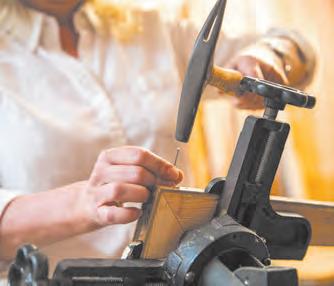



October 23
The Golden Isles Alzheimer’s Walk will begin at Neptune Park, 550 Beachview Dr., next to the Pier Village on St. Simons Island. The opening ceremony will kickoff at 9:45 a.m. with the walk starting at 10:15 a.m. Attendees can register for a 1-mile or 2-mile walk. Registration is open from 9 to 9:30 a.m. To donate or to register, visit gaalz.org.


from a Greek word “mousa” that means “art” and “poetry.” In the 1950s, Truman Capote, creating his own word version of muse, was inspired by his “swans” including Babe Paley, Gloria Guinness, and Lee Radziwell.
place that is almost like music. It inspires the creativity. It was the easiest movie to make,” he said.
Perhaps it started with Christian Dior. When the designer launched his fashion house in Paris, immediately after World War II, he debuted with a collection of 90 pieces that included voluminous dresses, skirts, and ball gowns that were created from hundreds of yards of fabric.
It was a hallelujah farewell to the spare, fabric-skimpy dresses of the war. Dior favored a model named Alla IIchun to stand for hours as he draped fabrics around her and studied the lines.
“Muse” is what he called her, taking
Eccentric artist Andy Warhol claimed Edie Sedgwick was his one and only muse. Though dead at an early age from a drug overdose, she is famous simply for giving inspiration to Warhol. She was related to actress Kyra Sedgwick so, by a further degree, to Kyra’s husband, Kevin Bacon, an actor so well-known having been cast in hundreds of projects that a game was created called: Six Degrees of Kevin Bacon. In our household, we can get to Bacon in one degree.
The Golden Isles are, collectively and separately, muses. It has been proven repeatedly over the years. This thought came to me recently when I was on the phone with a producer friend in Los Angeles. He shot a television movie on St. Simons a couple of years ago.

“Man, there’s something about that
That brought to mind that another director, who shot a Christmas movie on the island, had said something similar once. “It’s such a beautiful place to shoot that it makes the work easy.”
Playwright Eugene O’Neill was an early resident of Sea Island. The island was close to brand new when he and his wife, Carlotta, bought a beachfront lot and built a cottage there (the house is still there, though the lot is smaller) in 1932. For four years, O’Neill, an unwelcoming father-in-law to movie star, Charlie Chaplin, who had married O’Neill’s 18-year-old daughter Oona, lived there. While he turned out an abundance of short plays, it was there that he wrote the only comedy of his multi-Pulitzer, Nobel-lauded career. “Ah, Wilderness” is a sweet look at small town family life at the turn of the 20th century.
Although W. Somerset Maugham, Britian’s most successful writer, came
to visit them on Sea Island, it is pretty certain that Chaplin and Oona did not, although their marriage did last for 44 years until Chaplin’s death. Nor their daughter, Geraldine, who would become an actress. Beautiful with dark eyes and hair, she played the betrayed wife of Omar Sharif’s Dr. Zhivago.
The O’Neills did not leave the island for lack of inspiration. Sea Island had, unfailingly, been a delightful muse. They simply could no longer abide the island’s summer heat in the decades before air conditioning delivered relief.

Thirty years after Eugene left, Eugenia arrived and it would be she — Miss Price or Genie as she was known — who built a spectacular writing career on St. Simons Island. In her memoir, she is effusive about the love she felt when first she saw the island. She recalled that in the early 1960s the island was still so rustic that sometimes as she drove down Frederica Road toward Christ Church she would have to get out of the car and brush a limb out of the way. It was all trees, bushes, and overgrowth.
Eugenia Price had already built a strong foundation as an author of Christian and self-help books, but the small island that captured her heart and catapulted her to worldwide fame would be her private muse until the day she died. As Edie was to Warhol, so was St. Simons to Eugenia.
I understand. Some of the easiest writing I do comes when I visit Sea Island, St. Simons, or Jekyll. Once, Tink and I were at the Cloister for five days and, in that time, I wrote, incredibly, nine newspaper columns. On that particular trip, the words and stories came almost faster than I could type them.
Perhaps I’m unusual. I have two muses. I have the mountains of the Appalachians and I have the Golden Isles. Both fuel my imagination and storytelling. As I set out with this new mystery series and sleuth Stella Bankwell, I plan to step beyond my comfort zone and spend time on the other islands such as Sapelo, Little St. Simons, and Cumberland.
Maybe I’ll end up with a bookshelf full of Golden Isles muses.


Dad put the boat in, directed us onto Village Creek, and found a small opening that he thought of as a good spot, and we anchored watching the beginning of the outgoing tide.
“Give me your line, Sam,” Dad said.
But it held through while I pulled up a powerful shark.
“It’s a hammerhead,” I shouted in complete shock.
Salt water raised me, baptized me, and grounds my soul. Any child exposed to the tidal creeks and rivers is given a true blessing. At a young age, Dad took me out fishing countless times on our 17-foot Boston Whaler. I remember those early days on the way to the Village Creek boat ramp. Dad stopped at Circle K. He bought a black as midnight coffee for himself and a Milky Way chocolate bar for me. The early summer morning opalescent sky illuminated live oaks on Frederica Road.

We’re going fishing today.
I handed it over to him, and he placed a shrimp on the hook. I took the rod and cast the line. Within moments, the rod plunged straight down. A large fish took me by surprise as I almost lost the pole. My hands clenched the rod as the spool squealed, and the line ran under and around the boat. My heart pounded in anticipation of bringing up the biggest fish in existence or losing the rod.
“Be strong and reel it in, Sam,” Dad said.
I reeled and reeled for several tough minutes as he held the line up. My hands began to cramp.
Surely , I thought, this rod is going to break.
“That’s a bonnethead, son. I’m going to cut the line. Don’t ever stick your hand in a shark’s mouth. See these teeth,” he said.
Dad pulled back the light brown c-shaped head, clipped the line, and released the fish. He always offered safety tips.
“What a shark,” I replied joyfully.
For the next few hours, we caught spotted sea trout. One. Two. Three. Four. Five.
Now, we had dinner for mom and the sisters. We darted back up Village Creek after our day was done. The tide went out completely, and my dad could not figure out how he gauged the tide wrong. We were stuck in the
mud. The prospect of sitting locked in place under the blazing hot sun for two to three hours provided some confusion and eventually laughter. Dad called mom to let her know our predicament.
The sun intensified its grip. If hell exists, it’s this hot and humid all the time , I thought. Shortly, I became greatly bored. I laid in different positions. Sometimes my hat covered my eyes while I tried to zone out. Other times, I looked over the boat searching for something interesting to see. Mud minnows swam in schools in the green hue of the shallow clear water. Out of nowhere, a plump, beautifully patterned blue crab with a large, colorful blue and red claw emerged directly below my gaze.
“Dad,” I pointed and shouted. “Crab!”

“Grab the bucket,” Dad said in matched excitement. “I’ll use the net.”

Dad and I, profusely sweating with our lobster-suburned noses and cheeks, moved into position on the right side of the boat. Looking over, quietly, Dad leaned toward the water and in a darting swipe caught the blue crab. It pinched the net hard. Dad tried to shake him loose, but the crab stubbornly held on. Again, he attempted to grab him, and the crab gave a snapping jab.
“Sam, you have to be extremely careful when handling blue

crabs. They will pinch your finger off. They have two knives for claws,” he said.
“Yes, sir,” I looked on nervously.

He shook the grab loose after a few unsuccessful bangings on the inside of the empty orange Ace Hardware bucket.
Crab for dinner, too!
I looked on the other side of the boat and two more crabs were fighting. We caught them both. After another hour or so of catching half a dozen additional blue crabs, the tide pushed our boat just enough over the mud to make it back into the boat ramp.
That evening, my dad showed me how to cook blue crab. Put water in a pot and turn the stove on. I poured the bucket of crabs into the large silver pot. I watched the crabs in their final moments climbing in desperation while their compatriots pulled them back down. I felt bad for these crabs knowing that they are going to die.
But I soon came over that feeling after Dad cooked them and put them on the dinner plate with the fried trout. Nothing feels better than a cold drink and a plate of food after a hot day on the creeks. I ate quietly as I thought about the battle between me and that bonnethead shark.

warranty issues. They’re also able to share advice on maintenance.
Quality, too, is another element that they bring to the (literal) table.
“Outdoor furniture is expected to withstand a whole lot more than indoor, so expect to pay for that performance,” Sissy says.
“The quality of big box stores and large online retailers most often can’t match what you’ll get from someone who specializes in outdoor furniture.”
And there’s certainly plenty to choose from. At their St. Simons location, clients gravitate toward POLYWOOD and Breezesta furniture, Oriflamme fire tables, umbrellas, outdoor rugs as well as a wide variety of gifts and home decor.
In Kingsland, they often go for brands like Lloyd Flanders, Royal Teak, Tropitone, and POLYWOOD.
WORDS BY LINDSEY ADKISON | PROVIDED PHOTOSSwhat we thought would be a simple, coastal lifestyle retail store, Saltwater Porch+Patio, on St. Simons Island. We dipped our toes into the outdoor furniture market and our business took off.”
That was true in more ways than one. The two purchased the Kingsland store in 2022, allowing the Blanchards to create the largest outdoor furniture showroom on the entire Georgia Coast.
“Fire tables, in-pool products like Ledge Lounger and Tupelo Goods, and outdoor rugs are also in-demand there,” Sissy adds.
All of those items go a long way toward creating the perfect outdoor setup for any season — but it’s certainly key for the arrival of football.

It’s something that Becky Derrick knows quite well. Derrick is the wife of Frederica Academy Head Football Coach Brandon Derrick and has become very familiar with all things gridiron.
She’s also the vice-president of sales and marketing for Porch+Patio and has fab ideas for setting a game-watching scene.
Serendipity has played a major role in Sissy and Bob Blanchard’s life together. The couple spent most of their careers in retail, Bob working in the golf industry while Sissy manufactured gift products. The two also owned a wine bar and restaurant in Bodega Bay in Northern California.
The stars continued to align for the duo in 2018 when they were presented with the opportunity to launch a store near Sissy’s hometown.
“I grew up in Brunswick,” she says. “When we moved back, we opened
“We considered buying it just for the inventory, but many of our Golden Isles clients are customers there and it has such a strong North Florida loyalty, we decided to just build a team to accommodate,” Bob says.
The variety of merchandise and locations allows the staff to meet clients’ needs and expectations as completely as possible. Their small business model also offers a personalized shopping experience which includes complimentary space-planning and assembly, delivery, and install within a wide radius of the warehouse, as well as assistance with
“Sofas or sectionals that include chaises or large ottomans create comfortable lounging spaces that feel ‘indoorsy,’ so these are a top-seller,” Derrick says.
“We also do a lot of colorful counter- and bar-height chairs for backyard tiki huts. For people who don’t want cushions, a poly product with a high-curved back and a nice curve to the seat are the way to go for sitting through an entire game.”
She also recommends pulling in plenty of side tables so there’s no shortage of space for eats and drinks.
Porch+Patio offers items for perfect fall, football watch parties
“Poldina rechargeable, dimmable outdoor lamps have been big lately as people have become more aware of creating adjustable ambiance in their outdoor spaces,” Sissy notes.
Fire tables are another hot ticket item for fall, and the store offers sizes ranging from 24” to 75” in a variety of shapes and finishes. And of course, adding a little red and black never hurts either.
“We have plenty of options for all the Dawgs fans out there,” Sissy adds with a grin.
While gathering around the fire pit with friends and fam is certainly good for the soul, it seems it’s also good for the body. More and more studies are proving that embracing the outdoors is beneficial to one’s health, so creating cozy spaces can be an incentive to get outside.
“There are many studies that show the benefits of spending more time outdoors — natural light is better for your eyes than artificial; people often sleep better when their bodies are better aligned with the sun; more exposure to fresh air and Vitamin D can reduce stress, anxiety, and depression and may even increase your lifespan,” Sissy says.
The more families are able to curate and customize their outdoor oases, the more good times will continue to roll.

“For us, it’s really about creating lasting memories with family and friends — bonding over shared interests and strengthening your emotional support system — or enjoying that space solo if that’s how you prefer it,” Sissy says.
Derrick agrees.
“Hopefully, the time you’re spending in that space provides the mental peace you need to face what’s outside your outside sanctuary on the daily,” Derrick says.
• Porch+Patio is located at 3405

Frederica Road, St. Simons Island. The showroom is open from 10 a.m. to 5 p.m. Tuesday to Saturday. Porch+Patio in Kingsland is located at 1621-D GA Hwy 40 E next door to Willie Jewell’s BBQ. The showroom is open from 10 a.m. to 5 p.m. Tuesday to Friday and 10 a.m. to 4 p.m. on Saturday. Both stores can be found online at porchandpatiostore.com.





We’re proud to offer options to reduce body fat, lift and tighten— Liposuction, BodyTite and Morpheus8. These convenient in-office procedures are minimally invasive with sublingual pain management and have minimal downtime. SCHEDULE


attending medical school.
Every person, every family stepping into Hospice of the Golden Isles has a story. And that’s certainly true for Dr. Lindsey Rish.
The medical director of the Brunswick-based nonprofit has a personal connection to hospice care. Her father was diagnosed with leukemia and passed away at just 58, while Rish was
E“He had several months of really aggressive treatment and just said, ‘This is not what I want anymore.’ His oncologist supported him in that. Even so, he, like a lot of patients, thought, ‘if I enroll in hospice, I’m giving up and I don’t know if I am ready to give up.’ But he was to the point where he didn’t have any curative therapies left. It was more about how you want your care to look and what kind of support do you want for your family,” she says.
Rish’s family made the decision to call in hospice, but her father’s illness was nearing its final stages. In fact, he passed on the nurse’s first visit to their home. But in those short hours, she was able to provide a wealth of support.
“She only knew us for a few hours, but
we had a relationship. She helped us clean him up and called the funeral home. She even came to his funeral,” Rish says.
In the days and months following, the family reflected on the invaluable service that hospice provided, even in that short time span. And they’d wished they’d reached out sooner.

“We would have loved to have had that for the last couple of months. We could have met with her on a regular basis to understand what was going on with his decline,” she said. “I was in medical school at the time and they don’t teach you a lot about non-curative measures. We were all lost.”
That’s one reason Rish felt called to support those walking a similar path. She, along with dedicated staff of
Hospice of the Golden Isles, want to be able to give families the guidance they need to weather the storm.
“It’s a special breed of nurses that do this work. And everyone here ... the nurses, staff, the volunteers, the auxiliary members, they are all passionate about this mission because they have had their own experiences,” she says.
One of their primary focuses is to encourage families to make earlier connections with hospice. Whether that is the outpatient palliative care program or housing within their facility, this allows the team to work with families to create custom care plans. It also empowers patients, allowing them to direct their course of treatment.
“Hospice care now is very different than what it was in the 80s, where essentially you would just medicate actively dying patients. In the last

40 years, we have become very upstream. The focus is not just medicating during the last days. It’s about how can we support these families in a global sense. How can we offer the best quality of life in a global sense,” she says.
“We have patients on service for quite some time, and they go out and do their Bunco games. They do their poker games with their friends. They go on vacation. That’s what we want to see. We want to help them maintain that quality of life in whatever time they have left.”
Helping patients live the best life they can for as long as possible is at the forefront of Hospice of the Golden Isles’ mission. And as a nonprofit, the model allows them much more latitude when it comes to treatment programs.

“We want to understand their goals and what they want their lives to look


like. It might look different than under a curative model, but we want to help them live as well as they can. Then, when they are dying in those last days or weeks, we can help them die well with symptom management, plus that spiritual and emotional support for them and their families,” she says.
“It allows them to really be in control. And that’s why that early intervention and creating that connection is so important. I always say, ‘we want to help patients live well until they can die well.’ I think if you sum up hospice, that is what it should be, we should help them live.”
• Hospice of the Golden Isles is a nonprofit center based in Brunswick. For more information on Hospice of the Golden Isles, visit hospice.me.
PROVIDED CONTENT
As we age, additional support is often needed to assist with activities of daily living, whether due to overall health, accident, or disability. This support is often not practical or possible to obtain solely from family caregivers. With 70% of Americans over the age of 65 expected to need long-term care, making sure that you have a financial plan that allows you to afford quality care while protecting your financial assets is critical.
Long-term care covers a wide range of services but frequently refers to the six main activities of daily living used to assess care needs: Bathing or showering, dressing, getting out of a bed or chair, walking, using the toilet, and eating. When an individual is having difficulties with two or more of these activities of daily living, or if they need memory care, they are considered in need of longterm care. In addition, individuals may need additional assistance with physical, occupational and speech therapy, rehabilitation, skilled nursing services, or medication management.
Whether done on an in-home basis through a home health agency, in a
senior living community, or even with the assistance of family caregivers, longterm care can be expensive both in time and money. While actual cost varies based on the amount of care required, location, and specific health conditions — for example, according to Genworth, the current average cost of assisted living in Georgia ranges from $1,625 to $5,300 a month — the more robust your financial plan, the better you’re able to accommodate your specific needs.
The earlier you begin to financially plan for long-term care, the better your results. It’s not simply a matter of being able to take advantage of compounding interest in savings over the long term

— in many cases, there are specific long-term care policies that offer lower rates based on age and general health.

One first step is looking at the current costs of long-term care in your area or the area you plan to relocate to. This, combined with any information you have about your and your family’s health history and average life expectancy, will help you determine the average monthly costs that you may incur. It is important to keep in mind that the monthly fee paid to most assisted living communities covers more than just the cost of care — rent, utilities, dining, in-house social activities, local transportation, and maintenance are often included as well.
Some of the most common areas to explore when creating your financial plan include dedicated savings plans, longterm care insurance, government programs like Medicaid and veterans’ benefits, and assets available for liquification, such as a house. Understanding what funds and financial options for senior living are available is vital in your search. In many cases, individuals will use a combination of these avenues to pay for care.
Whether you plan to self-fund your long-term care costs solely through savings and asset management or use a variety of sources, consulting a professional in elder care planning can be extremely beneficial. The eligibility requirements of many government programs can be complex, and the different benefits, costs and limitations of insurance policies can vary widely. Informed guidance can help you make the best decision for your family, both in helping you protect your assets and making sure that you have all the documentation you need.
In state Medicaid programs, for example, eligibility is determined by a combination of assets, income, and need for care; however, not all assets are counted in that total, and individuals may have the option to spend-down — spending a portion of their money on health care-related costs to qualify for assistance. Because these vary state to state, and individual cities may have additional programs, working with a professional will help you get a comprehensive overview of what’s available to you.
Developing a solid financial plan for your long-term care needs will help ease your mind, provide you a starting point when evaluating support in your area, protect your family’s assets, and provide you with the highest quality of life even as your needs change.

• Addington Place is located at 890 Scranton Road, Brunswick. For information on making the move to senior living, call 912-513-4288.

allow yourself to be scared a little bit, and I think it’s even more important today, it focuses you on the present. It makes you be there where you are, when you are, at that time, and in this age of distraction.”
Thus, building a bouldering gym has long been a dream of Gowen’s. He scouted locations over the years, but the right fit never materialized. Until a day on the water with Tommy McGraw, that is.
DiVincent’s store stocks supplies for various outdoor enterprises from backpacking to fly fishing, and Gowen is the co-owner of SouthEast Adventure Outfitters, which shares the beauty of the Georgia coast through kayak and boat tours.
Now, the pair is joining together to introduce the centering culture of rock climbing to south Georgia.
While soaking up the sun, McGraw informed Gowen of his interest in purchasing the Kress Building downtown and offered him an opportunity to take a look at the space as it awaited renovations.
“I got to see it when there was nothing here, nothing on the second floor, nothing on the third floor,” Gowen says. “We looked at this downstairs space, and he asked if I thought the gym would work here. I said, ‘Yes,’ and the rest is history.”
A new place to hang is coming to the Golden Isles.
Born out of local entrepreneurs Jared DiVincent and Michael Gowen’s shared love of outdoor recreation and serving their community, the Brunswick Rocks bouldering gym will offer a welcoming environment to anyone and everyone searching for a new adventure.
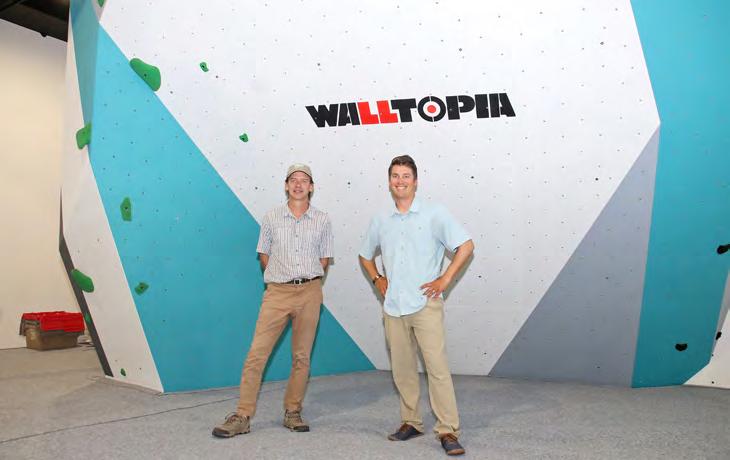
“With our passion for the outdoors, it’s just natural for us to try to introduce our community members to the outdoors, and ensure they love that space and want to protect it,” says DiVincent, co-owner of On The Fly Outfitters.
“I always enjoyed climbing,” Gowen says. “I played team sports growing up, but to me, climbing was just a great avenue for getting outside, but it’s also challenging in the sense you have to make decisions based on what it in front of you, you have to rely on your partner, you have to make weather calls. It’s more of an individual thing in the sense that the same climb becomes easier over time once you become better at it, so you’re really only trying to improve yourself and comparing yourself to how good you were before…
“The camaraderie, the culture of it, the idea that we can share our adventures, that you kind of get out of your comfort zone a little bit, that you can
It wouldn’t be long before Gowen partnered up with DiVincent, who had plenty of experience with climbing from his time in Telluride, Colorado, which holds an annual Mountainfilm Festival founded on the indomitable human spirit. It was there DiVincent would be introduced to Memphis Rox, the nonprofit model he would one day emulate.
Brunswick Rocks will be a nonprofit organization that welcomes all.
“We will open our doors to anyone, regardless of their ability to pay,” DiVincent says. “We’ll of course have community members around St. Simons, Sea Island, and the surrounding areas that can afford to pay for a pretty modest pricing membership to get access to our fitness classes and our climbing facility, but there’s also members of our community who don’t have the ability to pay. We want to make sure we have that structure in place for them to have access to the same things as the rest of the folks in the community.”
Brunswick Rocks will offer a program that allows volunteers to pledge five hours of community service a month at the gym or one of their nonprofit partners in the community, which already includes organizations like the YMCA, the Boys and Girls Club, and Safe Harbor.
Once the time is recorded and reported back to Brunswick Rocks, the volunteer earns a one-month membership.


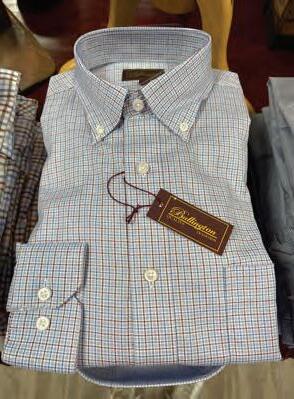


“If they do that every month, they will maintain their onemonth membership,” DiVincent says. “So it’s a way for them to give back to the community, invest in the community, get something back in return, and just build relationships with all members of the community.”

Along with access to the facility, members will be eligible for a cavalcade of classes taught by yoga instructors, team-building coaches, and other mentors around the area. Everyone who enters the gym will sign a waiver and go through an orientation before getting up on the wall.
The climbing walls were provided by Bulgarian company Walltopia following a year of design work. All the walls and pads were pre-made and sent over in a pair of shipping containers before being assembled within three weeks.
Climbing routes are still being set up by experienced setters. To keep the gym fresh and challenging, paths will be changed every month or so.
While the final touches to Brunswick Rocks fall into place, there is still some work to be done on the financial side. The gym is still looking for corporate sponsors, and they’re offering fully tax-deductible founding memberships via their website.

“We’ve done quite a bit of fundraising so far,” DiVincent says. “We’ve even put up some of our own funds to get to this point, but because it’s nonprofit, we’re still in need of some crucial funding to get the doors open and for our programing.
“One way to contribute is to go to BrunswickRocks.org. On our website, we’re selling what we’re calling a ‘founding membership.’ There’s one for adults, an individual membership that is $500 for 12 months of access to Brunswick Rocks, which is a discounted rate. You also get additional perks included in that membership: You get free access that first year to our classes — our yoga classes, meditation classes and so on. We’ll have a full calendar of fitness classes every single week for members to utilize. You’ll also get your name on what we call our wall of gratitude… We only have 250 of these memberships available — we also have them in the form of family memberships ($1,200 for two adults and two children)”.
burger here (at Certified)? Yeah, but, it’s just me, I love being out and doing that. It’s tradition, being out there and tailgating,” Smith says.
Getting the food just right is essential to the perfect game day festivities, and a good burger can steal the show.
“That is the hubbub about how to get a good burger, is the quality of your meat,” Smith says.

Ground beef is the most important part; it’s the foundation of everything else to come. Certified’s meat comes from Hunter Cattle Company in Brooklet, about an hour and a half from Brunswick near Statesboro.
Smith says all-natural, grass-fed beef makes a huge difference.
“You don’t have the steroids in it, the fat content — which is going to be a big factor. Your frozen one is just not going to do it for you,” she says. “And then we don’t season it with anything special, just a little bit of salt. And depending on how you like it, if you like it pink or burnt.”
Smith prefers hers medium.
“You either have a passion for it or you don’t,” she says.
The general manager role is somewhat new to her, but it’s her skill set that’s important for the also-relatively-new Certified Burgers, founded in 2016 and serving a wide array of specialty burgers. She’s been tasked with helping to expand the business and look at franchising opportunities.
“It’s still juicy, cooked, and it’s that right amount of pink,” she says.
Picking up some tips from the chefs at Certified is a perk of the job. One of those is how to tell how well-cooked your burger is. She uses the thumb method now.
As the ultimate fan fuel, a game day burger needs to be more than a piece of meat between two buns. Just ask Kerrie Smith. The general manager of Certified Burgers on St. Simons Island is well-versed on the matter.
She’s a recent émigré to the Golden Isles — originally from the Gulf Coast of Florida. She moved to Brunswick about a year ago from Savannah.
Smith’s background is mostly in corporate restaurant management at big brands like Honey Baked Ham and Smoothie King.
But that’s a good way off in the future, Smith says. Right now, she’s looking forward to the next game day. NFL is more her speed than college football — not to say she’s not a fan of some college teams … but in Georgia, there are some teams you can’t publicly support. When it comes to NFL, though, she’s a dyed-in-the-wool Philadelphia Eagles fan, stemming from her time living in Philly.
For any football fan, regardless of skill level or conference, game day is an institution to be observed with great care and lots of food.
“Who doesn’t like being out on the grill cooking for a game? Do I like a
“The firmer the more it’s done, the squishier you get the less it’s done … If you’ve been doing it for a while, you can touch the outside and it’s kind of like your thumb method. Down here is well done, medium, and alive,” she explained, demonstrating by pinching her hand from about an inch below the first thumb knuckle to just above it.
Just like the meat, fresh toppings are essential. All toppings at Certified come from local producers like Uncle Don’s Local Market on St. Simons or FreshPoint. Certified prepares everything fresh, aside from some condiments and the tater tots.
Another good tip is to let the burger sit for a while before digging in.
“It can marinate. Even with chicken, you don’t cut it within seconds; you want to let the juices get in there,” she says.

“It’s kind of hard when you’re at home and you’re served your plate, you go sit down and you cut it open. But, if you just let it go there for a couple of seconds, you’ll be able to tell the difference in the flavor and juiciness of it.”
A burger is a pretty basic food item, but how you prepare it can make a world of difference. That’s one of the selling points of the restaurant — its specialty burgers. The Buford Highway is easily her favorite — carrots, cucumbers, cilantro, jalapeños, Napa cabbage, and Korean BBQ sauce give it a unique taste.
Some others she loves are the Oaxaca — a chorizo patty, fresh avocado, jalapeño crema, cilantro, Oaxaca cheese, pickled red onions — and the Greektown — lamb and beef patty, lettuce, cucumbers, tomato, feta, and dill yogurt.
If the restaurant were to hold a People’s Choice poll, the American would outpace those without a doubt, though — a classic beef patty with some salt and pepper, lettuce, tomato, pickles, red onion, cheese, and, for some extra flavor, the restaurant’s house-made Certified Sauce on top. You can buy it by the bottle at Certified Burgers and Certified Pantry and Provisions, 44 and 24 Midway Square, St. Simons Island.

1 lettuce leaf
1 slice tomato
3 slices red onion
2 slices dill pickle
Directions: Grill up your fresh-beef patty to your liking. Use the thumb method if you have some experience, or grab a food thermometer. The internal temperature of a rare burger is 120 degrees; medium rare, 130-135 degrees; medium, 135-145 degrees; medium well, 145155 degrees; and well done, 155 degrees and over.
The FDA recommends cooking ground beef to 155 degrees. Add the toppings, drizzling on the Certified Sauce last, and finish off with the bun. Add some cheese and bacon for an even greater savory flavor.



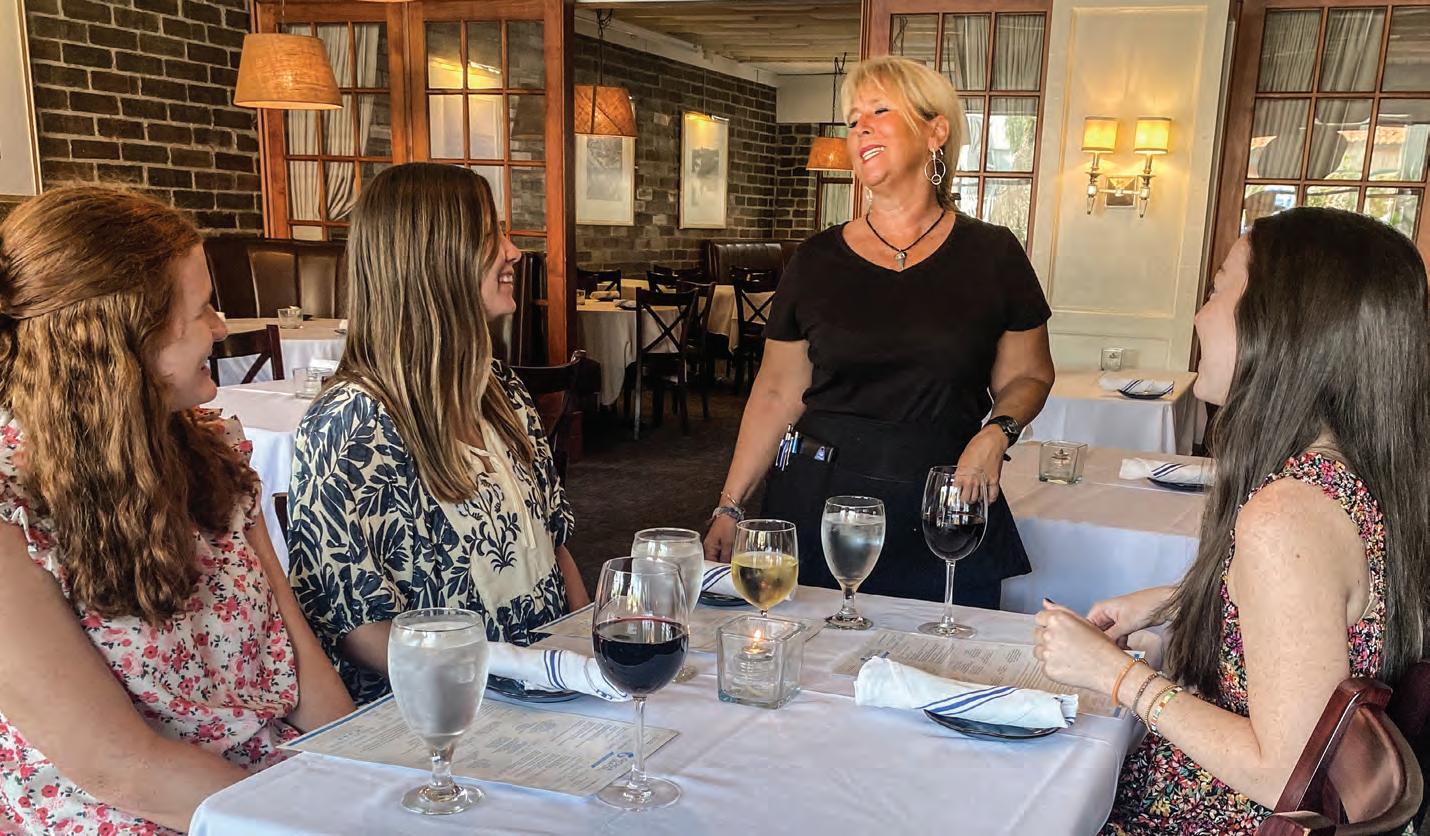



TToni Bagala squeezes the tube, dripping dots of blue ink onto her Yupo paper. She follows with a drop of clear alcohol, which sends the liquid shades spiraling across the page.
Then, she goes for gold.
“I finish everything with gold,” she says with a grin. “I love gold. I love when it does an effect.”
On this particular afternoon, Bagala was doing a simple alcohol ink art demo in one of the workshop rooms at Glynn Visual Arts on St. Simons Island. But she’s been working with the technique since before moving to the Golden Isles.
WORDS BY LINDSEY ADKISON | PHOTOS BY LESLIE HAND

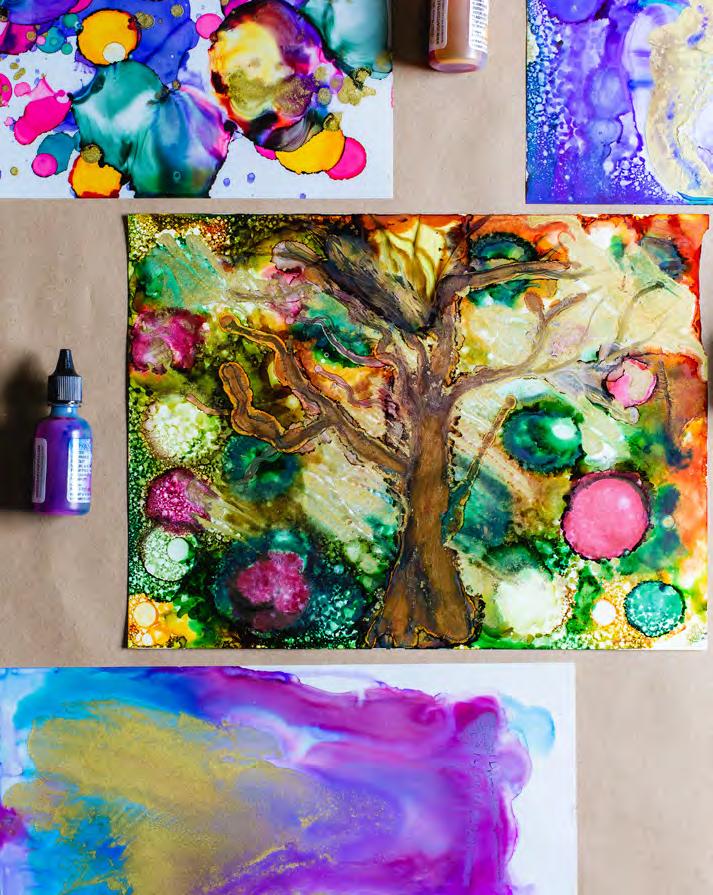

“I like it because it’s abstract. I can’t draw a straight line, It’s just a question of dropping ink and deciding what you want.”
Dolphin Tours | Private Boat Tours

Sunset Tours | Boat Weddings
Group Tours | Specialty Tours

Newest Boats in the Golden Isles
Up to 98 passengers

“I’m originally from New York State, but I moved to Atlanta for a job in 1992. I was there for 25 years and it was a high-stress job,” she says.
“So I started taking classes at an art center there. It became an outlet for me since my job was so stressful.”
Bagala started by exploring a variety of mediums. She tried her hand at pottery, jewelry making, and fused glass. But alcohol inks was one that held her interest over time.

“Alcohol inks was one thing that I did for many years, then I got away from it because I wanted to do other things,” she says with a chuckle.
Bagala moved to the coast in 2021, and as most artsy newcomers do, she soon discovered Glynn Visual Arts. The nonprofit situated at 106 Island Dr. offered a number of exhibitions and classes. But one they hadn’t hosted just happened to be alcohol inks.

“I stopped in and there was a new team. The new president and Michelle (Register, executive director) asked me what I did and I said, ‘well, a lot of mixed media and I do alcohol inks,’” Bagala recalls. “Then, they asked if I’d want to do a class.”

She obliged. But it was only the beginning of her affiliation with the center.


“They also found out I was an accountant in my prior life, so now I do their accounting,” she adds with a laugh.

Bagala offered her first alcohol inks class in October of 2022. And since she’s continued to share the method. Many budding artists appreciate the unrestrictive nature of the process, allowing more people to feel comfortable giving it a try.

“I like it because it’s abstract. I can’t draw a straight line,” she says. “It’s just a question of dropping ink and deciding what you want. Originally, I started it because I wanted to use it as background for other mixed media projects.”
Alcohol inks were developed by a company called Ranger in the 1970s. They still sell the ink tubes for artists today.
“I think they are undoubtedly best. I don’t teach with these because they’re too expensive,” she says.
“But I love how it’s all about what you want. I tell the students, don’t get hung up on the composition.”
The nature of the mixture — the alcohol with the inks — creates a constant sense of fluidity. One shape will meld into two, then the pairs will divide to form new configurations.
“You can use the air can and help them fan out. You can do flower shapes. Or you can use stencils like these from Michael’s. You really could just keep going so you decide when you’re done,” she says.
For her own work, Bagala begins with her color palette. Then, she works her shapes. Sometimes she will do entirely abstract pieces. For others, she creates a dreamy landscape scene with the colorful bubbles and blots.
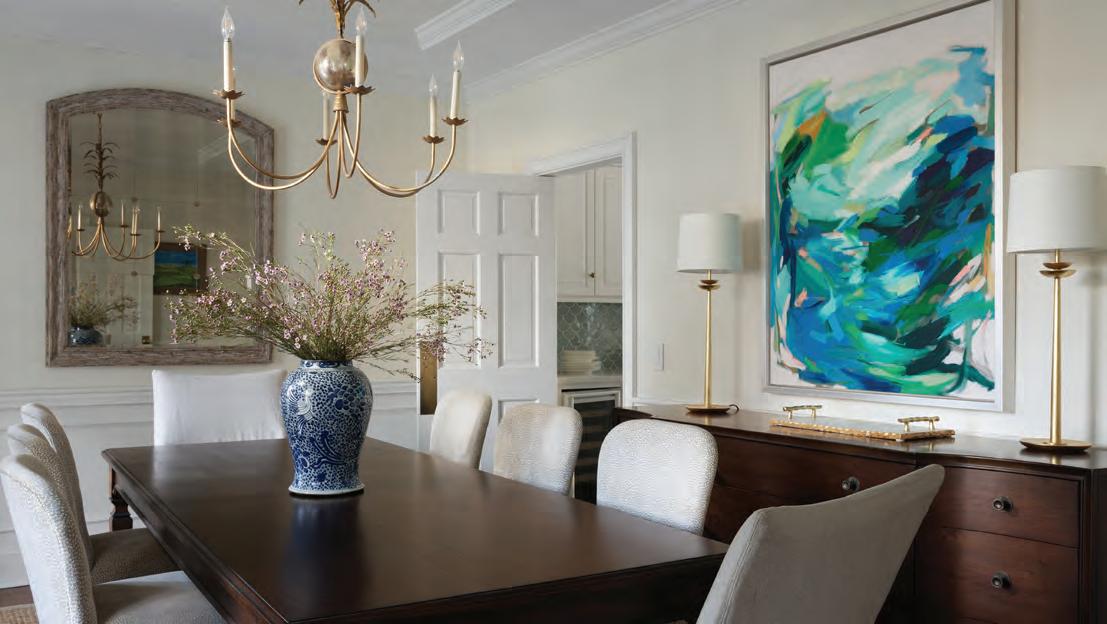
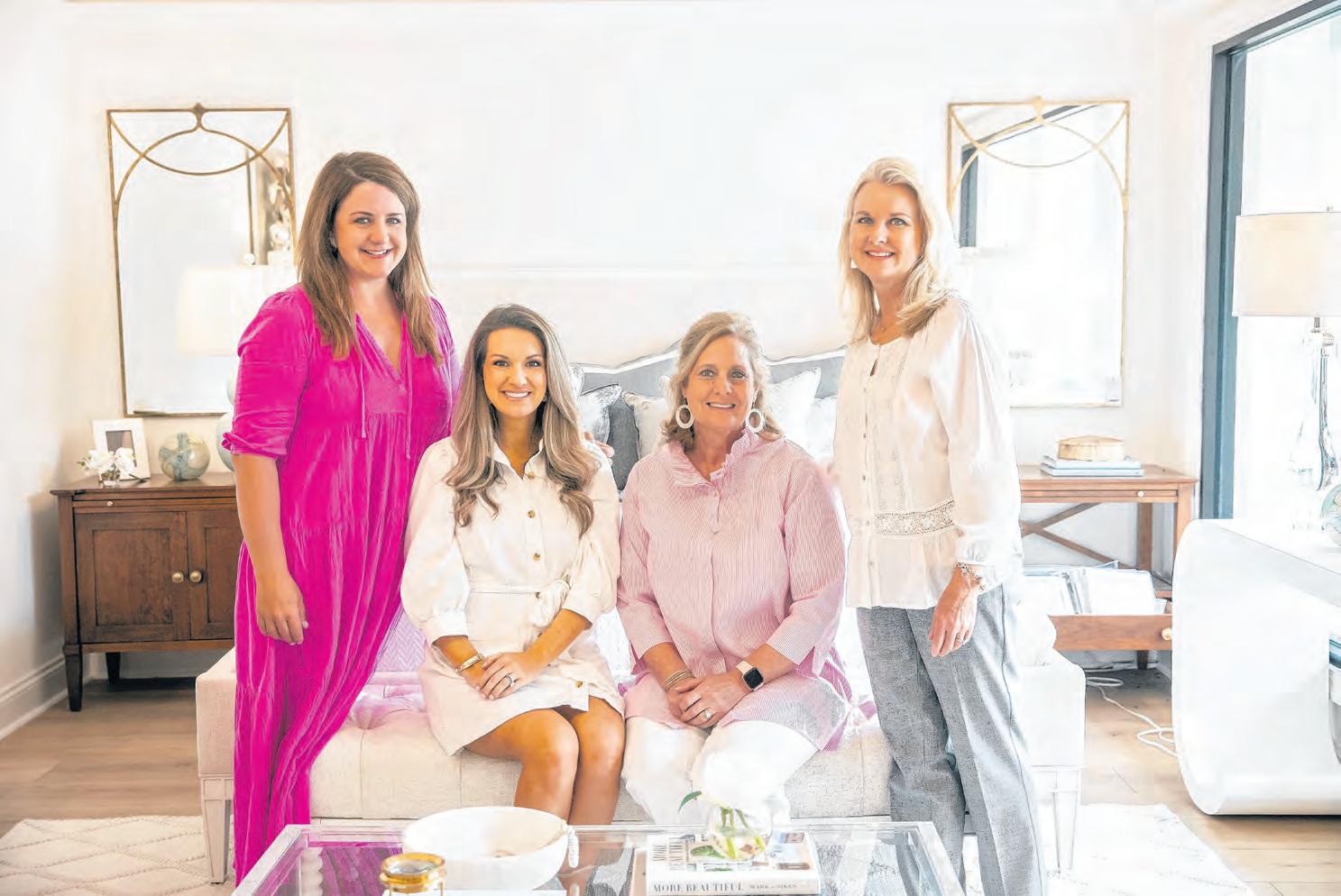
“I mean, it’s an abstract. But you can use the can air to make it look like clouds,” she says. “There’s so much you can do.”
Bagala is looking forward to offering more classes at Glynn Visual Arts in the coming months. But it’s not just the ink that she plans to share. She would also like to offer fused glass lessons.

“I don’t think that people realize how many classes GVA offers. There’s really something for everyone. You just have to get out there and try,” she says.

WORDS BY LINDSEY ADKISON | PHOTOS BY PRISCILLA BOUDREAU AND S AM GHIOTO
Weaving through the mossy roads of the St. Simons’ northernmost end, my eyes casually flit to my GPS.
Fort Frederica. Check.
“We’re getting close,” I assure my two passengers, summer interns who agreed to venture out with me on their first official interview.
I certainly wanted to seem like I knew what I was doing ... or at least, where I was going. The man we were going to see I certainly knew well ... I’ve been interviewing him for the better part of two decades. But finding his hidden home was a different story.
At last, we arrive. As we unpack ourselves — pens and pads in tow — the genius appears, beaming.
Kevin Pullen — painter, sculptor, teacher, all around Renaissance man — welcomes us with his trademark radiance, inviting us to come inside.
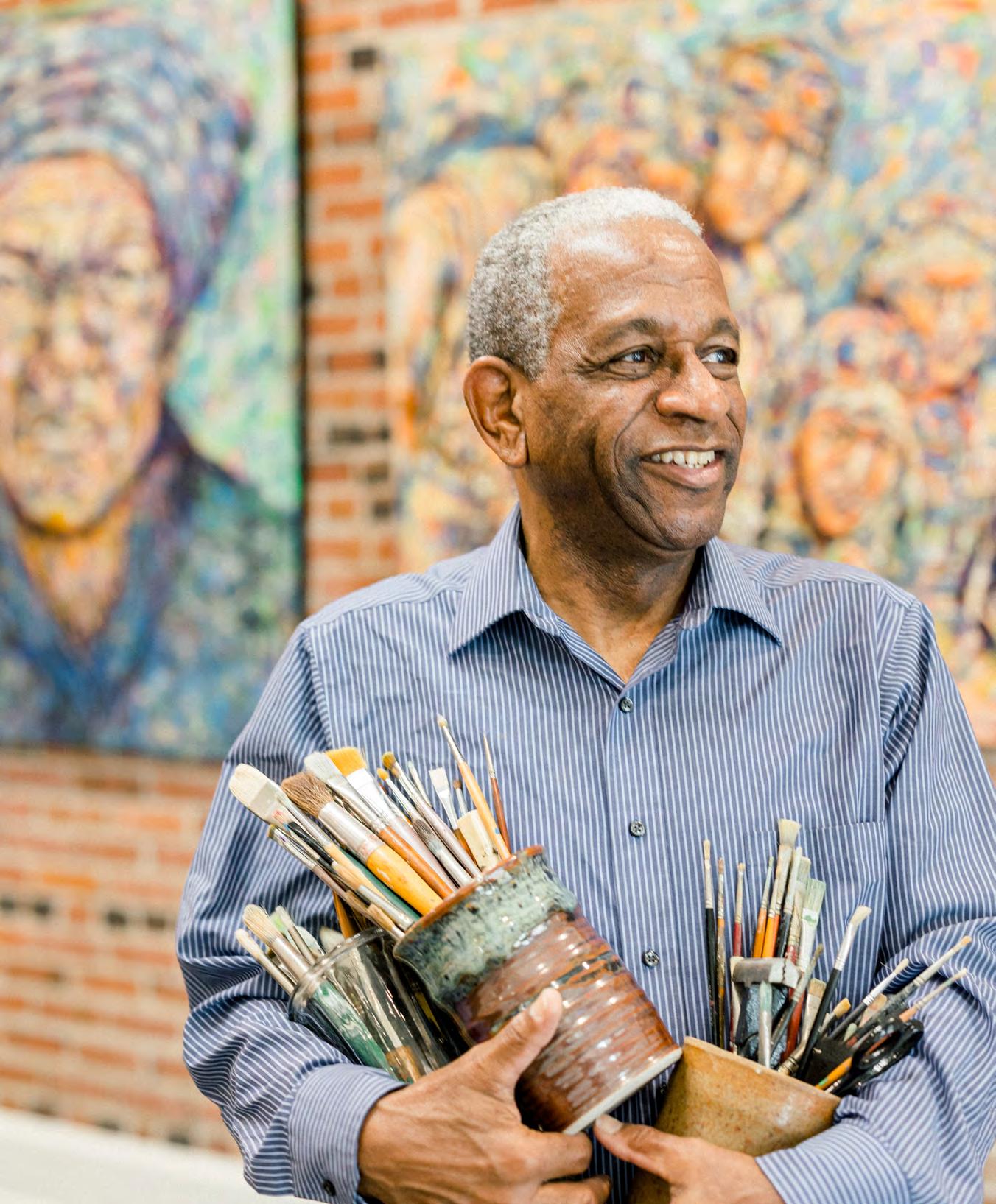



There, an army of statues offer salutations of their own — albeit silent ones. The faces of Martin Luther King Jr. and Jimi Hendrix peer out from their perches, as does a metallic bust of Keith Richards. These faces all have stories to tell. Their own, certainly, but also that of their creator, the man who freed them from the cold stone.
“It’s a little like a wax museum here,” Kevin says with a laugh.

While he uses both clay and canvas, more than anything, narratives prove to be this artist’s true medium. That’s especially true of those whose stories have slipped into historical postscripts.
The faces watch as we pass on, through the den, up a staircase, then down a hallway.
“Most of these rooms are empty now that our four kids are gone,” Kevin notes, pointing to closed doors.

We slide down a few more stairs, landing in his sun-showered studio. There, true to generous form, he’s prepared a tray of baked treats and coffee. Enormous canvases dot the room, including his own interpretations of the Flemish master Peter Paul Reubens.
“I did those a long time ago. I just love Reubens, the baroque painter. He would be in his house, which was basically a castle, directing this whole operation ... one person would be working on painting, just painting the animals and someone else would be in the background reading poetry,” he says with a grin, settling on a stool.
While Kevin could easily take his place among the master painters of yore, his own artistic journey began with sculpture.
“When I was a kid in kindergarten, I went into the classroom and my teacher, Ms. Johnson, God bless her, she had clay. And sister, she had a bunch of it,” he says with a grin.




“That was the only thing I wanted to mess with. I came in every day and went for that woman’s clay. She saw me making stuff with it and later she tried me out on painting ... that juicy paint. I did that one time and it ran. I was like, ‘I’m done with this.’ Give me the clay, lady.”
Even then, as a child in Plainfield, New Jersey, it was clear that this kid had an impressive and innate talent. Ms. Johnson clearly saw it.
“On the last day of school, she gave me a big brown paper bag. I just assumed it was for my parents, so I didn’t open it, but when I got home and gave it to them ... it was all the clay from the classroom,” he says.

That was the spark. Kevin followed his artistic passion through college at the Hampton Institute, now Hampton University in Hampton, Virginia. Armed with an art degree, he ventured out into the world to discover, as many have, that even with exceptional talent, carving out a life as an artist is anything but easy.


“I was living in my mother’s basement, as a college graduate,” he says with a laugh. “But one day, my mom’s friend who worked for an airline saw one of my sculptures and she really loved it. I said, ‘if you get me a job with the airline, it’s yours.’”
And so she did. Kevin worked in customer service, but art was never far from his mind.

“I was the guy in the red coat that you go see when something goes wrong,” he recalls. “But when it was quiet, I would secretly be reading art history books.”
Eventually, he left the industry and landed in education. That’s what first brought him to Georgia and later to the Golden Isles. But his family already had history with the peach state.

“My great-grandfather was a sharecropper who eventually made enough money to buy the farm. Then my grandfather bought a school bus when they wouldn’t let Black kids ride on school buses ... he was a spitfire,” he says. “He was adamant about voting too and wouldn’t cave to pressure from anyone. The family had to keep him hidden so people didn’t hurt or kill him. Back then, your vote could cost you your life.”

When Kevin arrived in Georgia, he found a more welcoming climate. And in the Golden Isles, the thriving artistic community opened its collective arms. Over
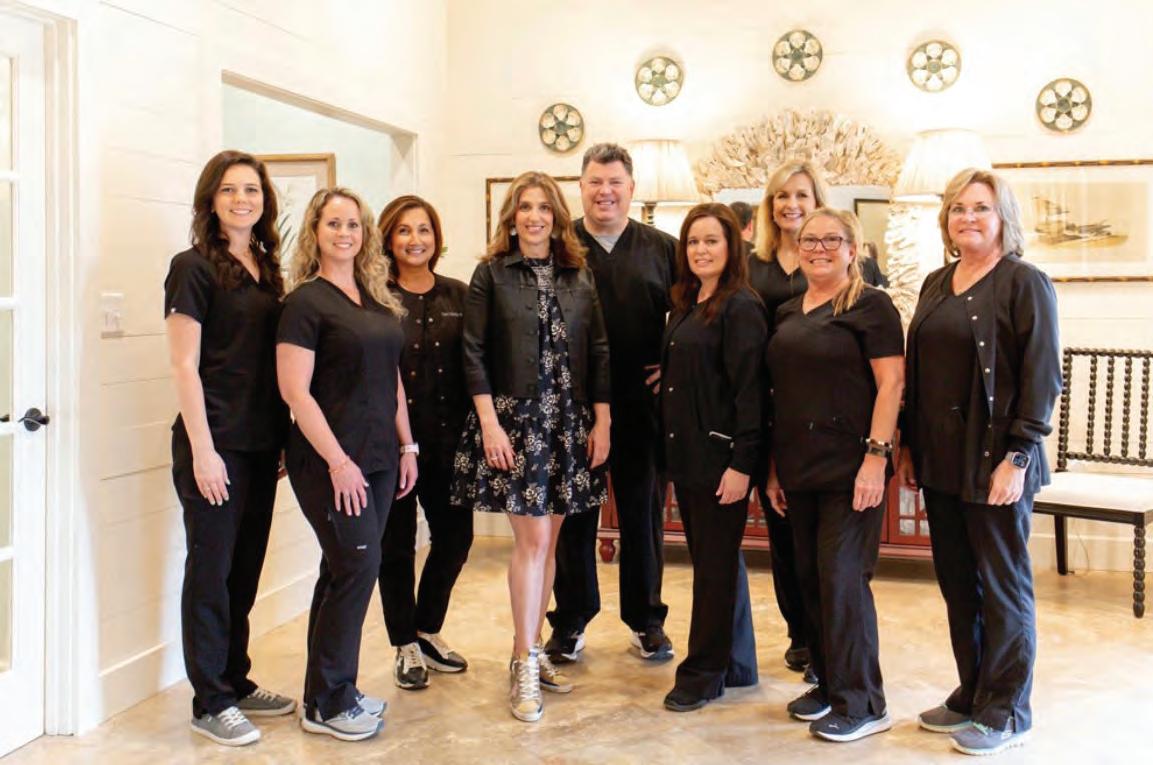
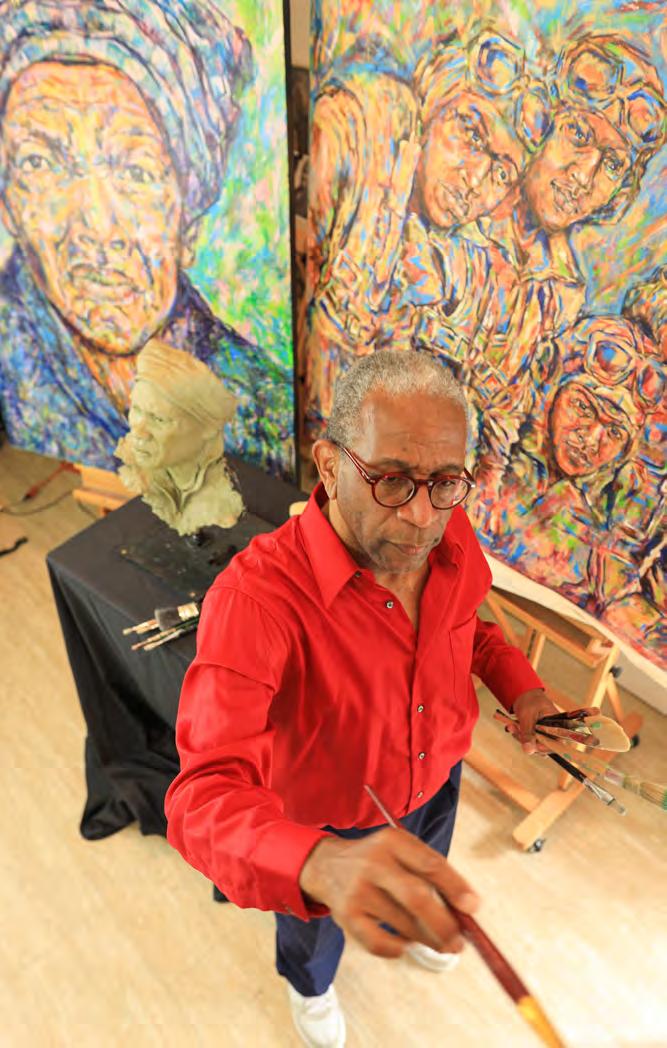








time, he learned the many moving stories of the people who came before him, particularly the stories of men and women of African descent.
“When I first moved here, I thought Neptune Park was named for the god of the sea. I didn’t know who Neptune Small was, but after I learned his story that really cracked things open for me.”
Neptune Small was born enslaved to the King family on the island’s Retreat Plantation. He accompanied the plantation owner’s son, Henry Lord King, to the Civil War. He later retrieved his body from the battlefield in Fredericksburg and brought it home. The story says Small was given property by the Kings — the land that’s now Neptune Park.
In the many decades since, Small has become a beloved local hero. Kevin created a sculpture of him, cradling the dead Henry Lord King. It’s since spawned multiple copies with the original now occupying the St. Simons Welcome Center.
But he wasn’t done. Kevin continued to seek out these intriguing, though unfortunately lesser-known historical figures. He sculpted the likes of Robert S. Abbott, a St. Simons native and lawyer who founded The Chicago Defender in 1905, which grew to have the highest circulation of any Black-owned newspaper in the country. He’s also painted social justice giants like Harriet Tubman and Nelson Mandela. Both of those along with a painting of the Tuskegee airmen are pieces of the Prince family’s private collection hanging in the downtown Brunswick’s Liberty Building.
“I just felt the need to tell these stories. To share these narratives, who they are, and what happened to them,” Kevin says.
It’s a personal mission. He knows firsthand the struggle of so many people of color, particularly those pursuing the arts.
“When you’re coming up as an artist of color, people assume that you didn’t do (the piece) or you’re not good ... or you’re not serious. I have been extremely fortunate that my work has been taken seriously,” he says. “But when people see me, they don’t see an artist … they see a Black artist. And there’s not a lot of us. I look around and I don’t see another me around here, and that’s not good.”

That’s why he feels compelled to champion diversity. It’s also why he feels it’s so important to share these lives through his work. His hope is to leave an artistic imprint for future generations.
“The other day my dear, darling wife said, ‘time is the new currency.’ I thought, ‘whoa, that’s
heavy.’ But, the more I thought about it, I realized time has always been our currency, even though we don’t know it. The older you get, the less of it you have and the more it’s worth,” he says.
“Time is also a measure of history. So when you’re measuring time, in terms of history, you’re talking about those moments that really mean something. They’re literally the currency by which we all exist. Eventually, we all universally go broke. We all run out of time. So the essence of the art process is ... I’ve got to tell time through art, because I’ll be gone, but the art won’t. The art will keep telling the story.”
“… SO THE ESSENCE OF THE ART PROCESS IS ... I’VE GOT TO TELL TIME THROUGH ART, BECAUSE I’LL BE GONE, BUT THE ART WON’T. THE ART WILL KEEP TELLING THE STORY.”
Kevin Pullen’s work will be featured in a new exhibition titled, “Look, Listen, Connect,” at Glynn Visual Arts, 106 Island Drive, St. Simons Island. It will be available for viewing September 13 to October 13. A reception


Nov 30th - Dec 2nd, 2023

At the strickland auditorium





epworth by the sea
Saint Simons Island, Georgia
Tickets start at $25


“Participating in the arts adds to your depth of knowledge. You learn about other cultures and customs. It opens your imagination to a whole new world, Art gives us the opportunity to see the beauty in the world and changes your life,” says Betty Oliver.
Glynn Visual Arts (GVA), the area’s oldest community arts center, is marking its 70-year anniversary and Betty Oliver has been there for all of them.
“I started taking lessons (at GVA) in 1953 when I was six years old. The classes were fun, and I went with several of my friends. It was in an old airport building, probably pre-World War II. It was a pretty derelict building,” she says, laughing.
The seeds that would eventually grow into the nonprofit GVA, were planted in 1950 by artist William “Bill” Hendrix and his wife Mittie, who established the Island School of Art on St. Simons Island. Two years later, the school evolved into the Coastal Center for the Arts, before eventually being renamed GVA.
While adults took classes during the week, Saturdays were set aside for the children’s classes.
“Bill Hendrix taught us watercolors, pastels, and oils. He let us do what we wanted to do. He was wonderful and such a fun teacher. Bill was an amazing person. He loved every minute of every day. His starting what is now GVA filled a huge void in our community. Other than a few sports, there wasn’t really anything for young people to do,” says Oliver, who credits Hendrix and the GVA with inspiring her to pursue her own career in art.
“I, along with many other kids, went on to have art careers or in art-related fields.” Oliver attended the University of Georgia and earned a B.A. in art, a M.A. in art history, and a Ph.D. in art appreciation/ aesthetics. She went on to teach art at Southern
Polytechnic University where she retired as a professor emeritus of media arts.
Although she became involved in GVA 40 years after the art center was founded, artist and former art gallery/ frame shop owner, Nancy Muldowney, feels just as passionate about the organization.
“My husband and I moved here in 1993 from Boston, where I had been part of the Cambridge Art Association and wanted to become a part of the arts community here,” she says.
Muldowney is an artist who specializes in rendering the natural environment through various mediums, including pastels, watercolors and acrylics, using paper, canvas, and fabric.
She was welcomed into the community and eventually served as the GVA board president twice.
Over the years, GVA expanded its offerings, including the very popular Art in the Park events, which bring talented artists and artisans to the Golden Isles, which were established during Muldowney’s tenure.


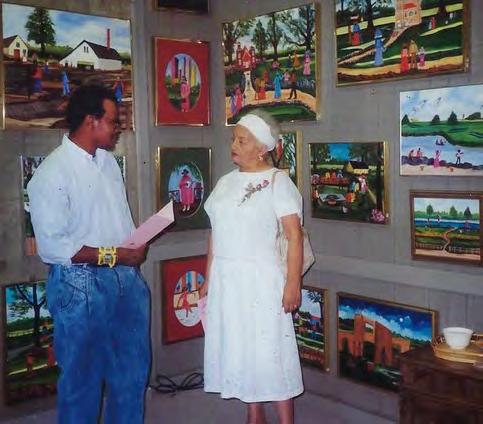
“Art in the Park was huge for GVA and the Golden Isles arts community,” she says.
GVA’s physical center also moved from location to location around St. Simons, including spots on Ocean Boulevard and Mallory Street, until landing at the Visitor’s Center in the Pier Village. Muldowney said while the high-traffic location was popular with visitors, the size
of the building did not allow GVA to house everything they offered onsite — most notably their pottery studio.
“We were not able to have the pottery studio onsite. When the board found our current location on Airport Road, we felt it was our best option. Buying the building meant we could have everything all under one roof, and all of us on the board felt that was important,” Muldowney says. “Having the pottery studio finally onsite, was a big plus.”
However, she adds that GVA still retains a gallery space at the Visitor’s Center. She also says the current location offers better parking and room to hold outdoor events, such as GVA’s Open Air Market, that Muldowney now serves as a volunteer. “I really enjoy being part of bringing art to the public,” she says.
GVA’s current Executive Director Michelle Register came on board in June 2022 and had to hit the ground running to prepare for this year’s 70th anniversary.
“Our big gala, The Art of the Lowcountry, was on March 4,” says Register.
The event was chaired by Oliver and held at the A.W. Jones Heritage Center of St. Simons, and The Art of the Lowcountry theme is being carried on throughout the year through exhibits, art festivals, workshops, and retreats (and in this issue of GIM).
“We are looking at having a retreat either on Sapelo Island or Cumberland Island or both. It may include nature walks and maybe a plein air art
This annual event raises money and awareness for the Georgia Alzheimer’s Foundation. As an Elder Law, Estate Planning, and Probate Law firm, we see firsthand how Alzheimer’s and other forms of dementia affect individuals and their families. We walk to score fundraising dollars for research, awareness, and support programs.

Scan here or visit https://rb.gy/zjl59 to donate or to learn more about joining a team; forming your own team; or registering individually.
Debbie
302 Plantation Chase St. Simons Island, GA 31522 912-268-2655 (office) • 912-223-3257 (mobile) debbie@debbiebrittlaw.com • debbiebrittlaw.com
10% off when you book directly by phone | 912.634.6056

Debbie Britt Law is a proud sponsor of the 2023 Golden Isles Alzheimer’s Walk.
group painting or drawing event. “Regardless of which direction we take, participation will be limited, since it involves going over in a boat,” she says, laughing.
Current and upcoming exhibitions will all be focused on the team and will showcase the works of low country artists, including GVA founder Bill Hicks. “We will also continue to offer mini sessions. Our demographic is always changing, with snowbirds coming and going as well as other visitors. We try to offer shorter sessions to meet those needs, but we also offer plenty of on-going courses that residents can participate in,” Register says.

“We currently have around 340 members and while we encourage memberships and depend on them to keep our programs going, all of our classes and events are open to the public,” says Register, who adds that members enjoy discounts on classes, workshops and lectures, as well as other perks. “We also rely on our many wonderful volunteers and are always looking for more, including talented teachers.”


Classes currently offered include courses in pottery, drawing, painting in various mediums and photography, as well as workshops on anything from printing to mosaics, jewelry making and more. “We were gifted a printing press which we have onsite, which is exciting,” Register says. “We also have various groups, including one in plein air, which meet regularly and are always open to more ideas from the public as to what they want to see us offer. We want to meet the needs of our members and the community.”
One popular offering is Open Studio Wednesday, Register says. “This takes place each week for our artist members for $100 a year as space is available. Artists bring their own art supplies in every medium to work on their art. It’s a social event where artists can get feedback in a sharing environment,” she says.
Register also said that their summer art camps are popular. “Those always fill up quickly,” she says. “We also just added a new program we hope takes off — the Teen Art Club. It’s free and open to anyone aged 13-18. You don’t have to be a member. It’s the second Saturday of every month and we bring in professional artists to bring their expertise and advise, while providing a safe space for teens to explore and share art. We have also partnered with the Boys and Girls Club to provide an art class at Burroughs-Molette School in Brunswick.”

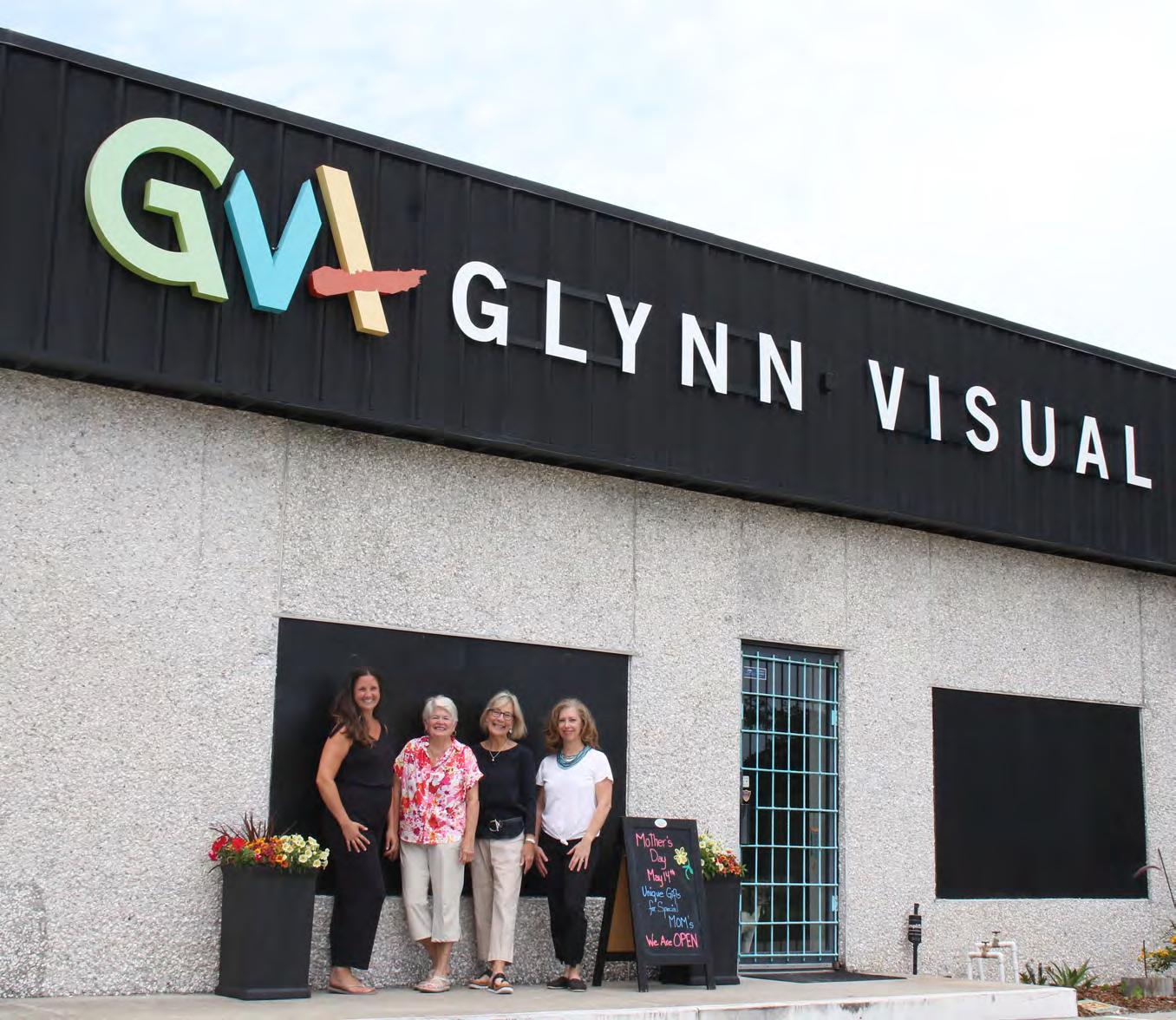

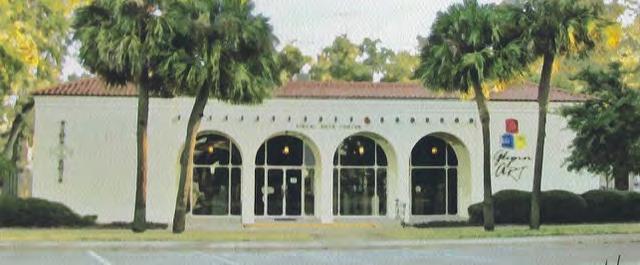
“I started taking lessons (at GVA) in 1953 when I was six years old. The classes were fun, and I went with several of my friends. It was in an old airport building, probably pre-World War II. It was a pretty derelict building,” says Betty Oliver
Register, who holds a degree in graphic design from Portland State University, came to the post with years of experience under her belt, including a stint as the director of marketing/art director with the Golden Isles Convention and Visitor’s Bureau.
She’s not only excited to plan out the remaining events for their anniversary year, but to continue GVA’s standard classes and programs. Register says the organization is also looking to expand its offerings.
“Our goal is to work more with the community, including holding off-site workshops and events, including some in Brunswick. GVA is also trying to expand our younger demographic to be around for another 70 years,” Register says. “Art is so important and brings joy to our lives.”
Oliver agrees.
“Participating in the arts adds to your depth of knowledge. You learn about other cultures and customs. It opens your imagination to a whole new world,” she says. “Art gives us the opportunity to see the beauty in the world and changes your life.”
• Glynn Visual Arts is located at 106 Island Drive, St. Simons Island, and is open Tuesdays-Saturdays, from 10 a.m-5 p.m., as well as for special exhibits and events. For more information, including classes, workshops and membership details, call 912-638-8770 or visit them on the web at glynnvisualarts. org or through their new Facebook page at facebook.com/glynnvisual.

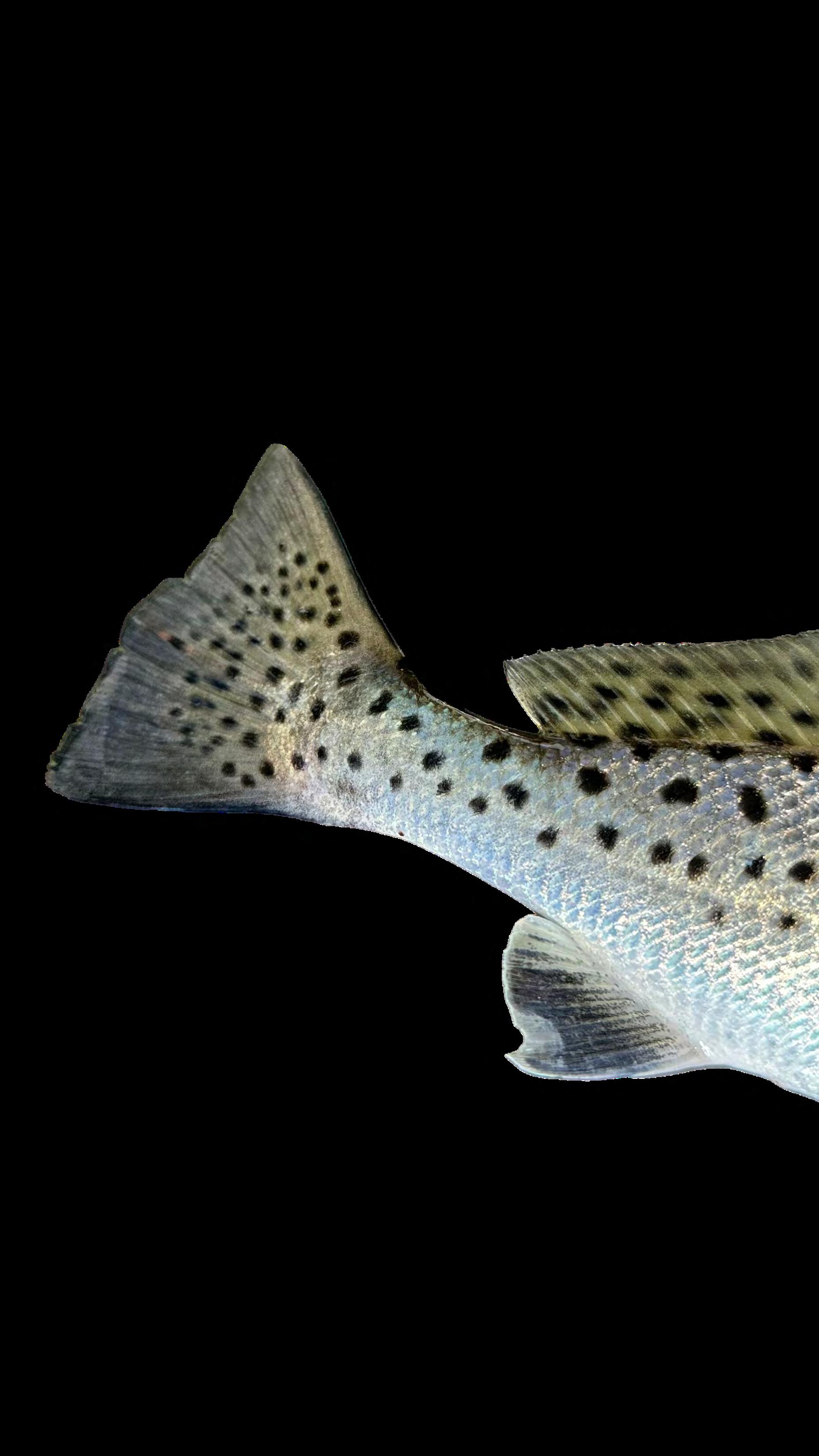




Centuries of enslavement and unspeakable deprivation in a foreign world an ocean away from their homeland could not extinguish the enduring spirit of the African soul.
Through it all, that indomitable essence survived, thrived, and flourished. It went on to imbue profound and indelible influences on the American experience, particularly in music.
Those contributions are present in all musical genres, from the joyous syncopation of jazz, the irresistible rhythm of Delta blues, or the stirring tempo of the bluegrass banjo (an African instrument.) But the very essence of that musical legacy may have been lost to posterity if not for a resolute group from a wooded pocket of rural McIntosh County.
Because of the tightknit Gullah Geechee
community of Briar Patch, the ring shout still bears testament to humanity’s unquenchable yearning for freedom. A stick beats a rhythm that is accompanied by foot stomping and handclapping, creating a mesmerizing beat. Dressed in his Sunday best overalls and a straw hat, a songster belts out baritone verses of redemption and deliverance.
Ladies donning heirloom dresses and headscarves respond melodically, shuffling in a counterclockwise movement while pantomiming the song’s narrative.
The origin of this intricate melding of song, rhythm, percussion, and choreography took flight under bondage during enslavement in the Antebellum South. But its roots are firmly planted in Africa.

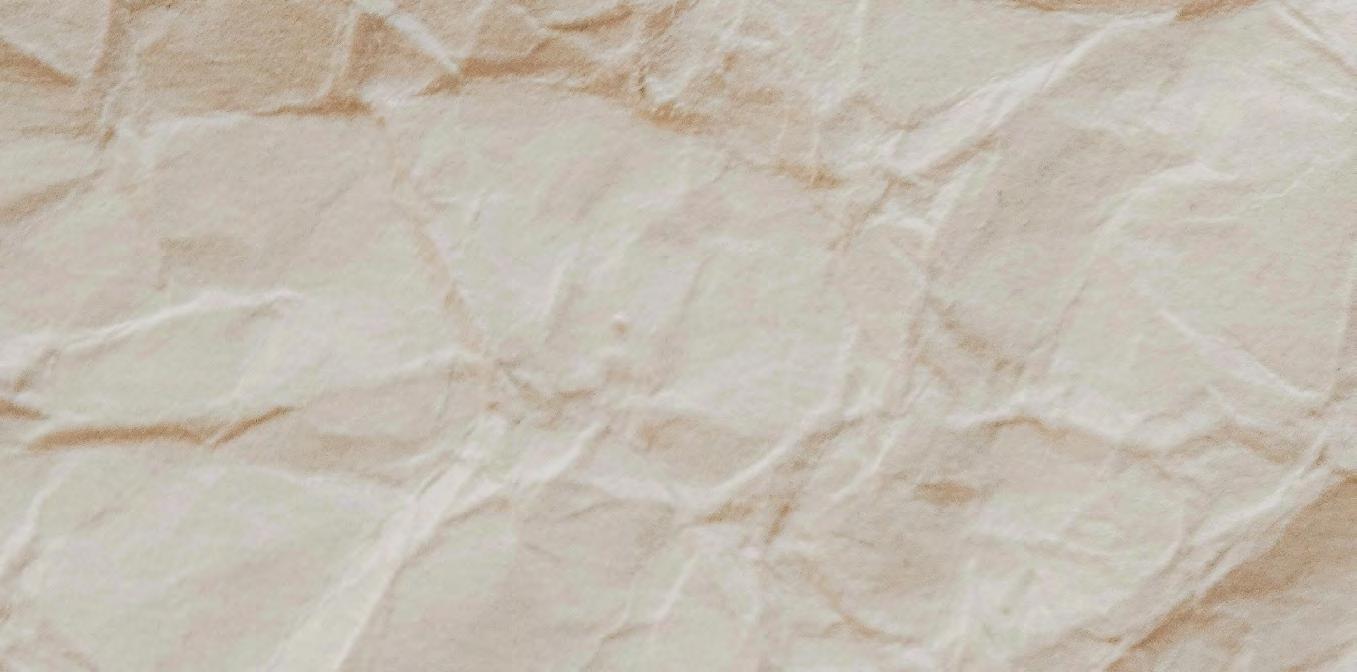
That McIntosh County group alone nurtured this jubilant practice into the 20th
century and up to present times — from the famed singer Bessie Jones of the Sea Island Singers to the contemporary McIntosh County Shouters.
Art Rosenbaum’s 1998 book, Shout Because You’re Free , tells how the ring shout links the two continents for its participants.
He writes, “there is little question … the basic elements of the ring shout were bought from Africa.”
The McIntosh County Shouters have performed on stage from Washington, D.C., to Boulder, Colo., and were recently featured in the Civil War-era independent film, Freedom’s Path. The Gullah Geechee Ring Shouters splintered off from the original group; it also has performed to national acclaim on stage and in film.
Participants dedicate themselves to maintaining the spiritual elements that crossed the Atlantic in the hearts of their forebears.
“I can definitely say that the ring shout has always stirred something special in me,” says Brenton Jordan, 36, a stick man for the McIntosh County Shouters.
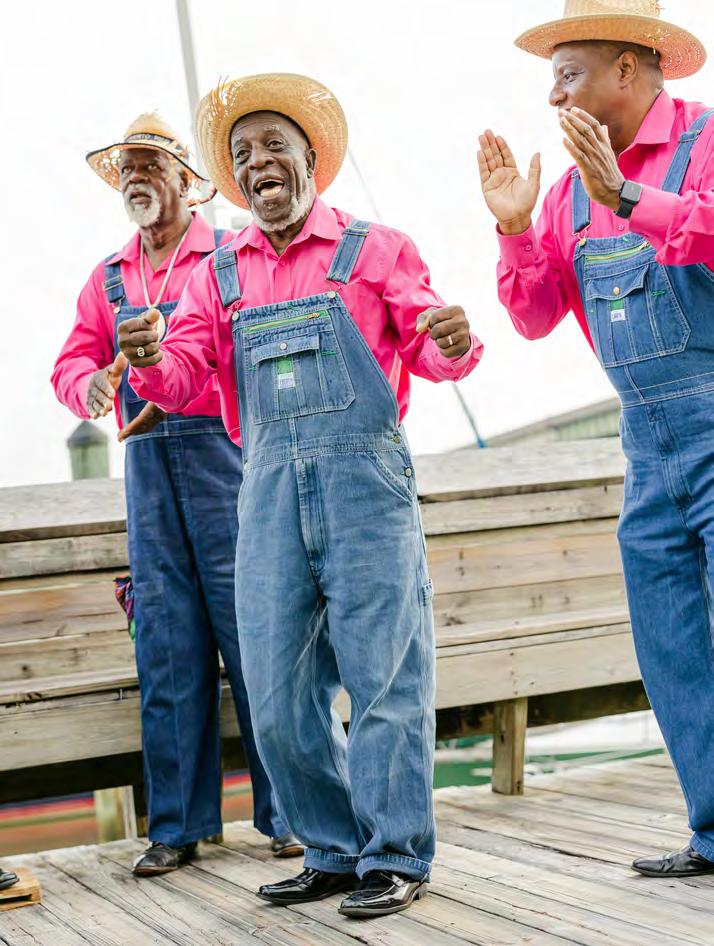
The contemporary incarnation of the ring shout serves as a direct link to long-established cultural traditions, says Griffin Lotson of the Gullah Geechee Ring Shouters.
“We keep it raw, trying to give it to you like you were on the plantation back in the day,” Lotson says. “We stand on the shoulders of the generation that we learned from. They stood on the generation before that, and the generation before that.”
has introduced new residents to the Golden Isles and to new friends for over 15 years. It’s a great way to settle into life on your new Island home.
As a Newcomer, you’ll access social, educational, and volunteer opportunities that expand your horizons, your appreciation for life in the Golden Isles, and your new circle of friends.

Activities like:
• Member Meet & Greets
• Small Group Dining In/Dining Out
• Island Adventures Tours

• Social Activities
• Sports Activities

• Volunteer Activities.
This stretch of Coastal Georgia is steeped in Gullah Geechee culture, defining a proud people who established self-sustaining communities along coastal Georgia following emancipation.

The ring shout is integral to that heritage.
Its incorporation of these most basic elements was born of necessity during enslavement. But it would be a disservice to describe the overall result as simple. The rhythm produced is complex and multifaceted, while the songster’s call and the shouters’ response teems with underlying meanings.
Accompanied by the songster, the stick man and a clapper, the shouters vigorously shuffle in a counterclockwise movement that is not quite a dance. They are careful not cross their feet or lift them, as their adopted Christianity


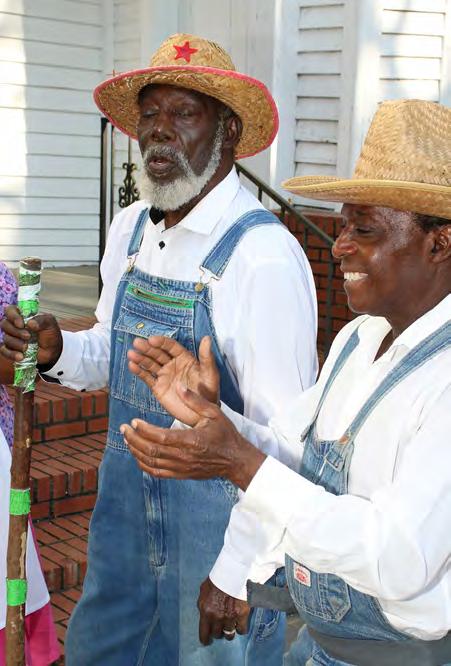

forbade it. Deep body bends, swaying arms and movements by these ladies portray story lines such as that of an eagle’s liberating wings in “Move, Daniel.”
“You can’t just say, ‘We’re putting together a group, and we have a shout,’” explains Brenton, who received the United States Artists’ 2023 Beresford Award. “No, you don’t. If you’re not allowing yourself to rise, crack and fall, if your feet are not doing what the stick says to do, then you’re not doing it.”


Brenton learned the tradition at his grandmother’s knee in the Briar Patch community. In addition to mastering the complex beats of the stick man, Brenton’s considerable singing chops are occasionally featured on songs like “Blow, Gabriel.”
“If you grew up in Briar Patch, you were
exposed to it at an early age,” says Brenton, who also pursues African dance. “There was always a spiritual pull to it. My grandmother did it and my great-grandmother did it. For me being a lover of music and a lover of African dance culture, it was as though I were unconsciously drawn to it.”
Polytheistic West Africa tribal practices, as well as north African Islamic practices, infused with Christian expression for the enslaved. The term “shout” may refer to the “Afro-Arabic term “saut,” sometimes pronounced “shout,” meaning a fervent dance around the Kabaa in Mecca,” Rosenbaum writes.
West African spiritual influences are evident in the shouters’ counterclockwise movements. These represented the sun’s movements in the African sky, following
cycles of birth, life, death, and afterlife.
Slaveowners’ attempts at eliminating these practices proved futile. A slaveholder in Liberty County reported in the 1840s that, “he heard within these songs both resistance to subordination and profound spiritual insight that cut through his pretensions … ” according to Shout.
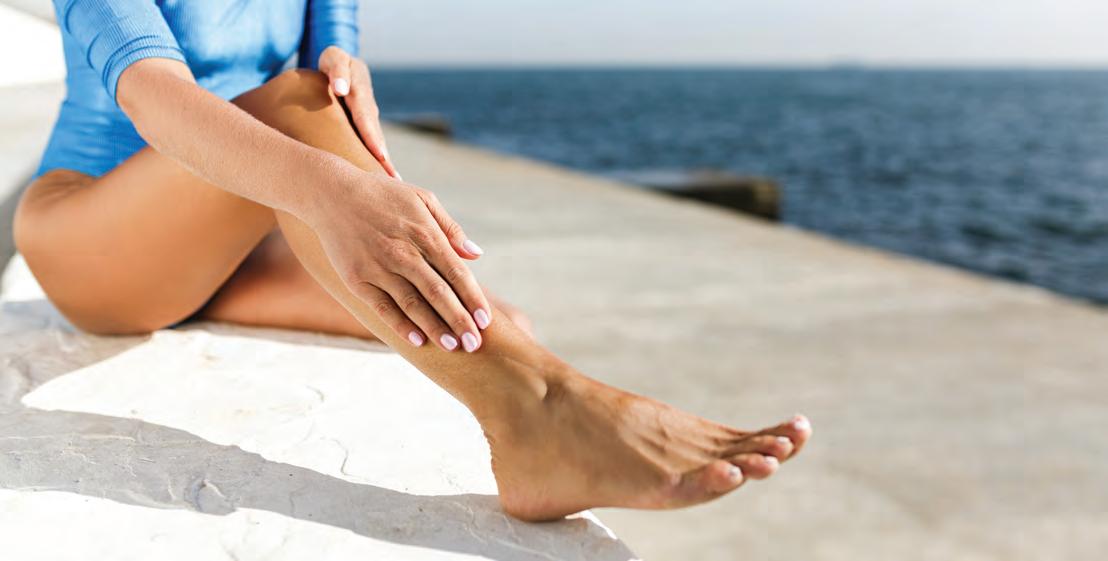
Inherent in African culture, drums were prohibited after a bloody South Carolina slave revolt in 1739. The enslaved hardly missed a beat in adapting and nurturing those distant ties.
The book Shout quotes an early white observer: “In the ring shout and allied patterns of ecstatic behavior, the African heritage of dance found expression in the evangelical religion of the American slaves.”

“We keep it raw, trying to give it to you like you were on the plantation back in the day,” Lotson says. “We stand on the shoulders of the generation that we learned from. They stood on the generation before that, and the generation before that.” Griffin Lotson says









Lydia Parish of St. Simons Island promoted the shout and its attendant African musical traditions in the early 20th Century. The daughter of abolitionists with a love of African American music, she persuaded practitioners Bessie Jones and Joe Armstrong to form the Sea Island Singers. With help from black linguist Lorenzo Dow Turner and folklorist Alan Lomax, their music reached national audiences at Carnegie Hall and in music festivals from Newport to the Smithsonian.
Writes historian Melissa Cooper: “Lydia Parrish began a relentless quest to prove that the slave songs she collected and the ring shout performances she observed were definitive evidence of African survivals in America.”
Meanwhile, the good folks of Briar Patch continued without fanfare to answer the inner calling of the ring shout. This most commonly occurred at the Bolden Home Lodge or after church services at the Mount Cavalry Baptist Church. A longstanding tradition there included marathon New Year’s Eve sessions during Watch Night. This longstanding African American tradition celebrates the enactment of Lincoln’s Emancipation Proclamation in 1863 during the Civil War.
Around 1980, former Sea Island Singers Frankie and Doug Quimby were pleasantly surprised to learn of these ring shout traditionalists in McIntosh County.
Writes Rosenbaum: “With the help of folklorists Fred Fussell and George Mitchell, the Quimbys located the shouters of Bolden (Briar Patch), who were persuaded to form a group that would present the traditional practice … all the elements of this pre -

sumed extinct tradition were presented conscientiously, much as the elements had been reported by 19th century observers.”
The subsequent Smithsonian Folkways recording, The McIntosh County Shouters: Slave Songs from The Coast of Georgia, put the ring shout on the national map. It led to the aforementioned performances on stage and screen for the McIntosh County Shouters, and the formation of the Gullah Geechee Shouters.

Brenton has taken to heart the powerful undercurrents the ring shout held for his ancestors.
“As I got older, I began to realize that the stirring in me was a connection with my ancestors,” Brenton says. “In so many ways, it wasn’t until I did some deep diving into the history of the transatlantic slave trade that I began to recognize this.”
Griffin traces his lineage back to enslaved relatives on a plantation at Harris Neck. In the ring shout, he honors the promise of freedom that only stirred from within for his ancestors.
“When you do this, it has to come from the heart, mind, and soul. Just imagine you are there. There is no hope, you’ve been dehumanized. You don’t have freedom like other people.
“And there you are in this moment and you let yourself go spiritually. For this brief moment, you can imagine that you are free,” he says.
His voice lowers to a whisper.
“Free as a bird.”
the Sacred:
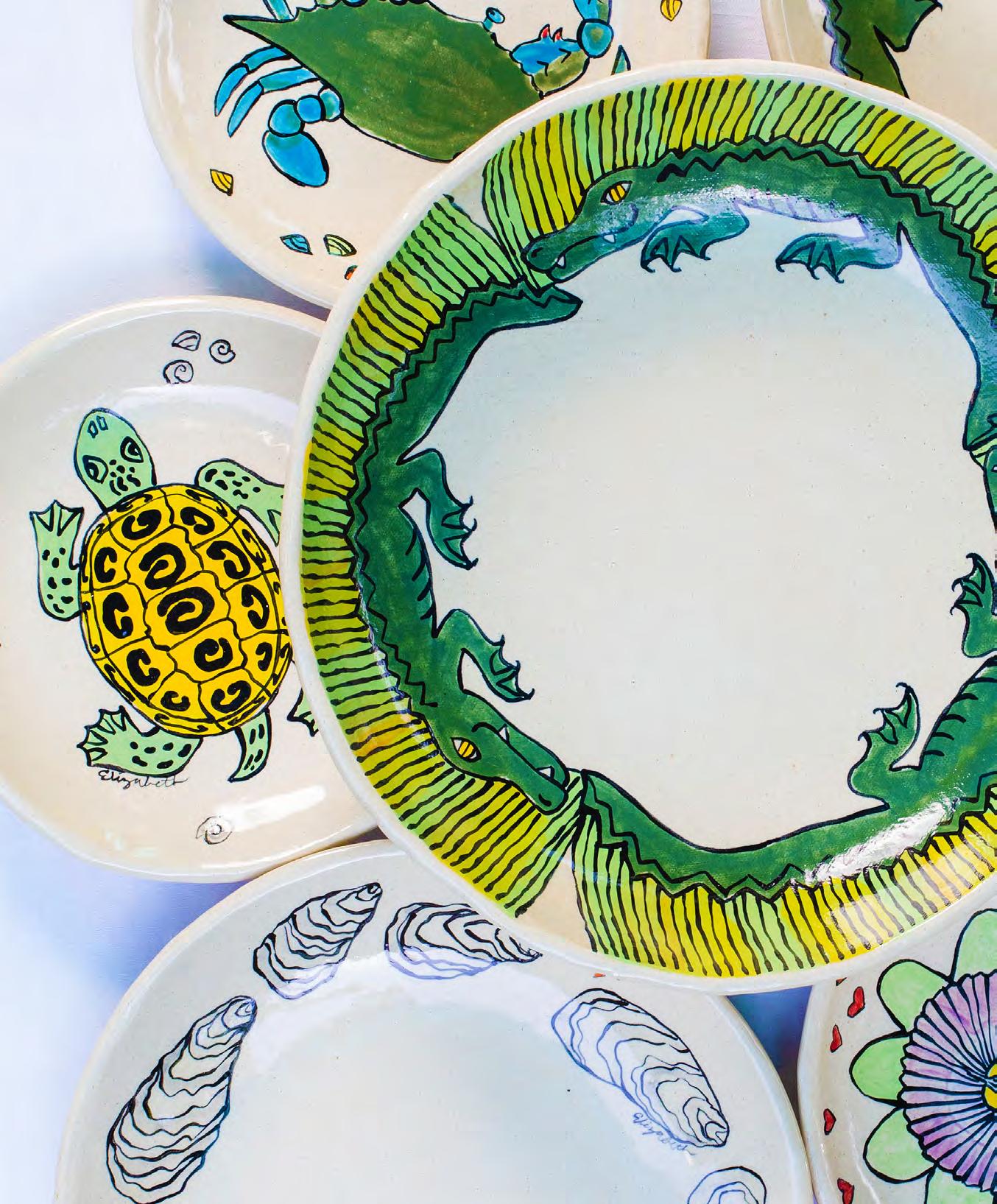 WORDS BY LINDSEY ADKISON
PHOTOS BY LESLIE HAND
WORDS BY LINDSEY ADKISON
PHOTOS BY LESLIE HAND
White plastic table tops sat speckled with colorful splashes, evidence of bygone painting parties. Typically, when they’re not workspaces, they’re covered and dressed for openings and events held here, at Glynn Visual Arts.
But today, they were serving a different purpose — a place to sit down for an interview with Elizabeth Hayes. Sweeping in from her natural habitat — the pottery studio — she dropped into a seat, a blue mug of her own design clasped in hand.
For Hayes, the journey of becoming an artist and current director of GVA’s pottery studio, began when she was a child.
“My dad was in conservation, so we grew up on St. Catherine’s Island. It was very wild ... he always jokes that we were ‘mostly feral,’” she recalls with a laugh. “But I always describe it as being a place where there is nowhere to spend money. There’s no paved roads or sidewalks. If you didn’t bring it with you, it’s not there.”
The lack of distractions allowed time to cultivate an unfettered sense of creativity. Hayes whiled away the days, drawing, coloring, and molding clay.
“I also loved playing with marsh mud. One of the first things I ever did was to make these


“Pottery, particularly dishes, is something that humanity has been doing forever, which is really so special when you think about it,”
— Elizabeth Hayes
little marsh mud animals. I would hide them in the framework of the porch, so we’d have these little mud mice peeking out,” she says.
The island is a National Historic Landmark, located roughly 50 miles south of Savannah, between St. Catherine’s Sound and Sapelo Sound. Each day, Hayes was surrounded by vistas filled with tidal pools and marsh grasses. There was also, of course, the expansive seashore along with all the creatures that call it home. It proved to be an ongoing source of inspiration, as was gathering around the table at the end of the day.
“My favorite part of the day was supper. It was getting everybody together talking about the bird sightings or whatever adventure you had that day, minor or major. Then, eating the food. My father would catch fish for dinner. Or we’d eat fish and grits for breakfast. That’s still my favorite meal to this day,” Hayes says.
Another lasting impression from her unique childhood is the love of the flora, fauna, and wildlife of the coast. Over the years, as she honed her pottery skills, these themes played heavily into her work. Most of her pieces today feature drawings of alligators, crabs, plants, or oyster shells.



“It can be that I’m just really into alligators one month and into flowers the next,” she says. “But I have noticed that I go with the seasons. In the spring, I tend to do






more birds. In the fall, there are more feathers and leaves.”
While her designs often have a whimsical element to them, there’s also a sense of deep connection to nature. That’s something that she also hopes to pass on to those who purchase her pieces.
“I think a lot of times, they see something like a sea turtle, a bird, or a particular flower and it holds a memory for them. They may have watched a sea turtle release on Jekyll for instance,” she says. “Or it’s something they saw on vacation. But when they see it on a
plate, it takes them back. For me, the idea was always that people would pull out these plates and dishes with these animals and it would start a conversation. You might care about these animals and if you care about them, you want to conserve them.”

It’s not only about fostering links to nature, it’s also about holding space for human interaction. And so many of those take place around tables, becoming an intersection of the routine and the sacred.
“It truly is ... it’s very routine but also very sacred,” she says.





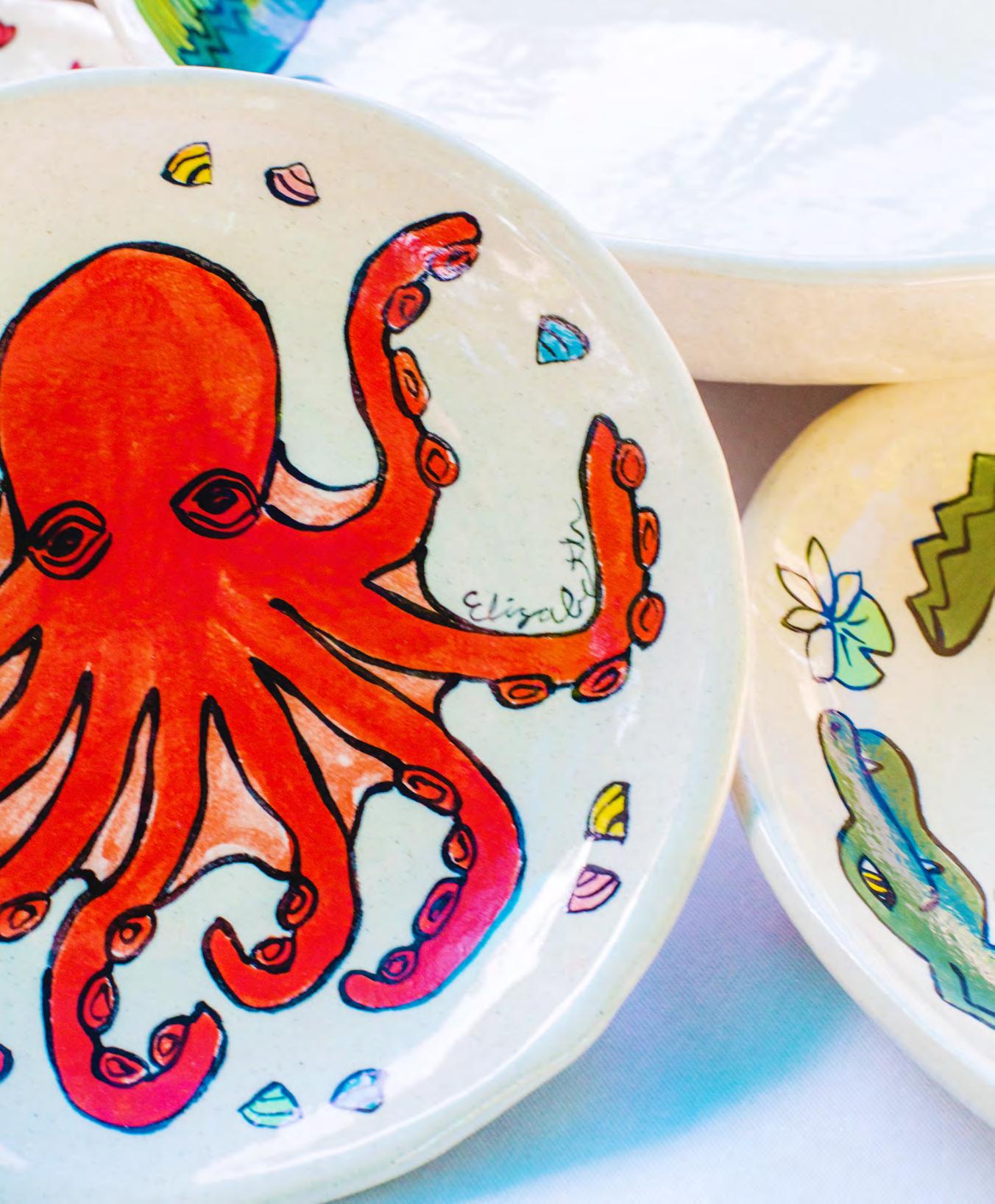
It’s a similar kind of bond that’s forged between generations of artists. As Hayes’ hands shape her clay, she understands that she’s continuing a deep tradition. Not only does it flow between local artists like Debbie Craig, her predecessor who handed Hayes the keys to the kiln at GVA, it spans millennia — from the coast of ancient Greece to the sands of Egypt and temples of Israel.
“Pottery, particularly dishes, is something that humanity has been doing forever, which is really so special when you think about it,” she says.
That’s why she is so quick to encourage others to try get their hands in clay. But if that’s not something that appeals to them, Hayes adds, any medium will do. It’s the process of creating that is most important.

“I have so many people tell me that they’re not creative, and I just don’t believe it. All humans are creative, we just find different ways to do it. It might be the way you decorate your home or set a table. It could be the way you fold your towels like Martha Stewart. It might be the way you pick wild flowers, but I guarantee there is something,” Hayes says. “People have creativity in them. We are all artistic. But it’s about feeding it.”
• Elizabeth Hayes is the pottery studio director at Glynn Visual Arts on St. Simons Island, where she teaches pottery courses and hosts weekly workshops like Friday Fire. She also participates in local art shows and sales. Much of her work is available for viewing on her Instagram page, @ElizabethPottery.


James Filer may not fit the description of your typical Pine Box Dwellers fan, but that won’t stop him from catching every show when the Waycross band comes to the Golden Isles.
Filer, who goes by Filo, makes rap music. The Pine Box Dwellers call themselves a “cosmic country” rock duo. Filo is aware it may not seem to fit to see the Black rapper jamming to a country rock song by two White guys from Waycross, but that is exactly why he loves and makes music. Music is the great equalizer, Filo says.
“If you make art, I make music. We have something in common,” he says.
J“If you see me and I’m tapping my feet to The Pine Box Dwellers, we have something in common.”
Filo got his nickname in high school, when teachers would mispronounce his last name and his classmates played around with it as well. Filo just stuck, he says.
It also became his identity as a rapper, musician, and producer, which has resulted in two albums featuring his own original tracks and a few collaborations along the way.


His album Filo the Leader, released in 2018, is available on Apple Music, Spo-
tify, SoundCloud, and other streaming platforms. Instrumental hooks on Filo the Leader are backed by finely-crafted beats that provide the foundation for original Filo rhymes, complete with plenty of local references and stories. Filo produces the beats, lays down the instrumental pieces he needs, and produces much of the music himself. He leans on knowledge gleaned over years of messing around with keyboards and software in high school and later interning at Drowning Fish Studio in Philadelphia.
“They called me the good-vibes coordinator,” Filo says of his internship. “I was like a runner, going and picking
up things the studio needed. I also ran cables and set up equipment, things like that.”
His time at Drowning Fish taught him much of what he uses today to produce his own Brunswick brand of hip-hop and rap. There is no one primary influence Filo uses in his music. All music is his influence.
His open musical mind means Filo finds himself collaborating with all sorts of local musicians, from rappers to jam bands.
“I play a lot of instruments very terribly, but I get what I need out of them,” Filo says. “I love all kinds of music.”
He cites a French pop-rock band called Phoenix, formed in Versailles in 1995, as one of his favorites. Add to that bands like The Pine Box Dwellers or the jam band Umphrey’s McGee, and it becomes clear Filo gets into a little bit of all of it.


“I don’t want to try to sound like anybody in particular,” Filo says. “Everything can be an influence. All of it.”





He has performed around the Golden Isles and in Jacksonville. Most recently though he has frequented open mic night on Mondays at Palm Coast on St. Simons Island. There, Filo may freestyle with a guitarist in an improvised performance or debut a new song he has been crafting.
“We have some of the most talented people down here,” he says.


Whether it’s a freestyle session or working at his home, Filo says his original music is an emotional release for him.
“It’s just fun,” Filo says. “It’s like a diary. I can say the same thing to my therapist, but it’s different to put it into a track. It’s more personal.”
Filo is not a shy person. He will admit he is actually pretty blunt and unafraid to speak his mind. His music is his outlet to balance it all and to express himself in a healthy way.
“I don’t have to keep it pent up,” he says. That’s why he is not trying to become famous or to make big bucks with his music. Making music simply makes him happy.
“I don’t really have a trajectory,” Filo says. “It’s never been about being famous. I like feeling. I like feeling like I’m good at something. I feel like I have a talent for it.”
Rahab’s Rope exists to empower women and children in the fight against human trafficking. Profits from our local and global artisans fund the mission.



Supporters of the Golden Isles Penguin Project attended In the Wings, a special event to benefit the program. It was held at R eid’s Apothecary in downtown Brunswick. It included food, drinks, and tickets to the show. For more information, visit goldenislesarts.org.
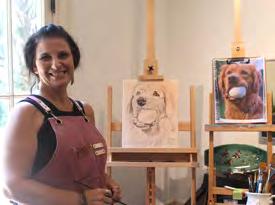










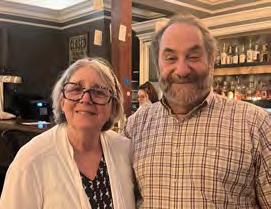

The Jekyll Island Arts Association recently hosted an opening reception for a new exhibition titled Animal House, which featu red pet portraits by Michele Levani and pottery by the Jekyll Islan d Potters. The association operates a gallery at the historic Goo dyear Cottage in the Jekyll Island Historic District. For details on their upcoming exhibitions and programs, visit jekyllartists.com.
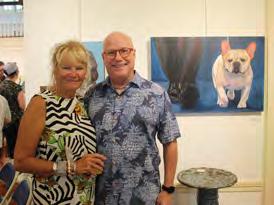


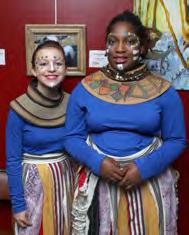
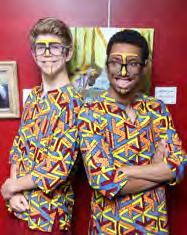

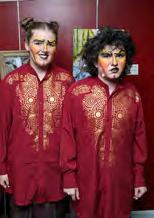
Glynn

Arts on St.
Island recently hosted an openi ng for a new exhibition titled, Then and Now. It celebrated the works of longtime local artists as well as newcomers. The show was part of the art center’s ongoing 70th anniversary celebration. For d etails about Glynn Visual Arts and its programs, visit glynnvisualarts.org.
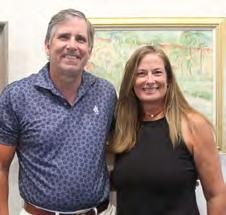
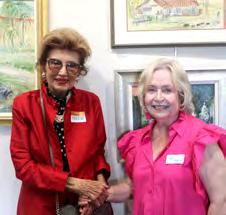


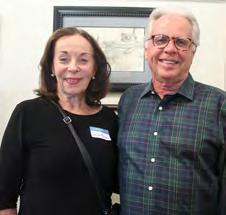




The Golden Isles Penguin Project recently staged “The Lion King Jr.” at the Ritz Theatre in downtown Brunswick. The program features actors with special needs along with mentors who help them with the production. It’s organized and hosted by Golden Isles Arts and Humanities. For details, visit goldenislesarts.org.



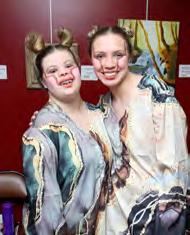

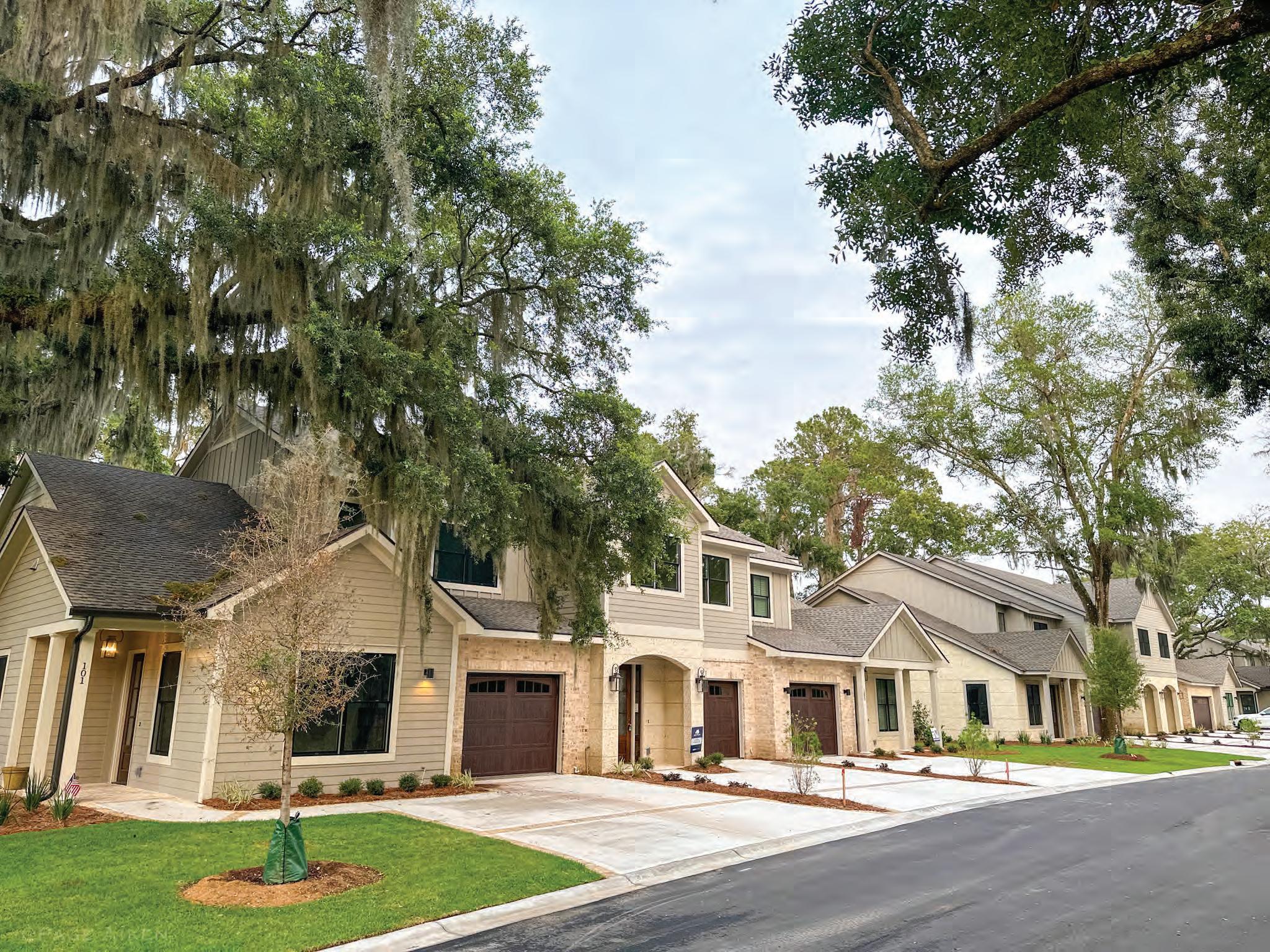
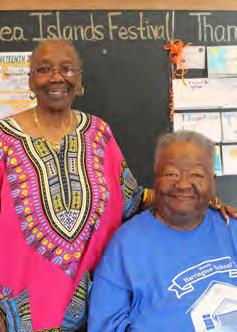
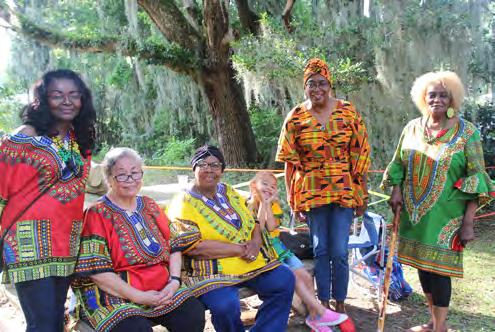


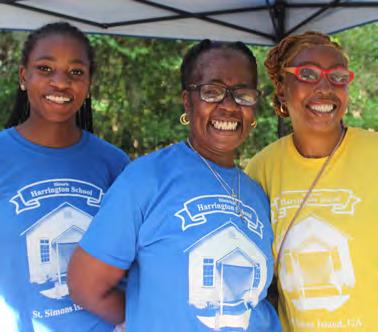


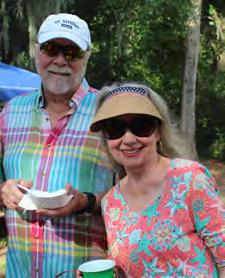
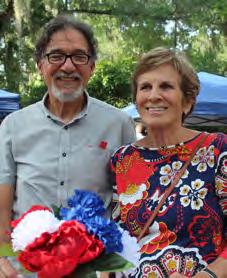

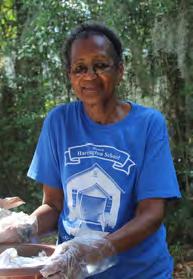
The St. Simons African American Heritage Coalition recently hos ted its annual Taste of Gullah at the Harrington Schoolhouse. A variety of food that represents the Gullah Geechee traditions was availabl e for sampling, and entertainment was provided. Proceeds from t icket sales help fund educational programming. For more information, visit ssiheritagecoalition.org.
 Ann Shepherd, left, and Ernest DelBuoro
Ann Shepherd, left, and Ernest DelBuoro

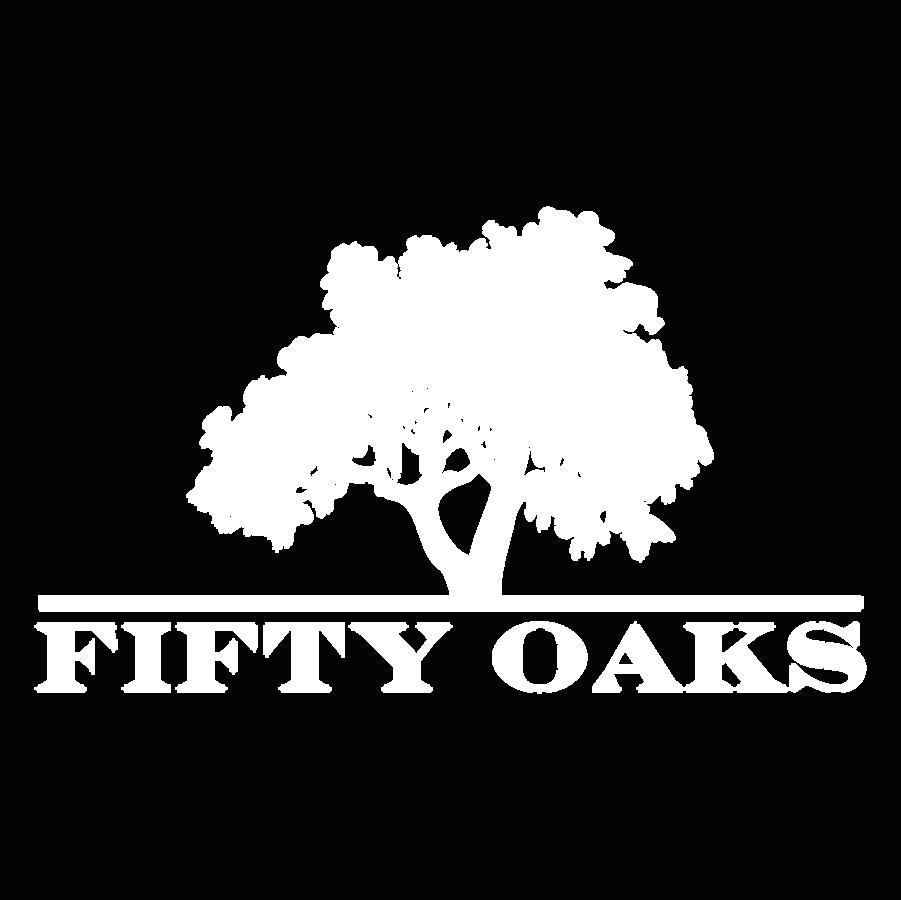


SEPTEMBER 22, 4 P.M.
Deliver your decorated bra to the Foundation by Friday, Septemeber 22 at 4:00 p.m.
OCTOBER 1 – 31

Bras will be on display in Brunswick and Camden at Southeast Georgia Health System. Vote for $1 at either campus, or vote online at wearethefoundation.org
NOVEMBER 3, 6 P.M.
The Historic Ritz Theatre in Downtown Brunswick
For more information, visit wearethefoundation.org or call 912-466-3360.
Proceeds benefit Southeast Georgia Health System cancer care programs.
